Butter Chicken Recipe (Beginner-friendly, Better than Restaurant)
Behold! A beginner-friendly Butter Chicken recipe with the signature restaurant oomph, made in one pan, ready in under 40 minutes. This recipe promises a silky, buttery makhani sauce with tender chicken. Tested well over 2 dozen times, in comparison with several restaurants, this is the Butter Chicken recipe of your dreams!
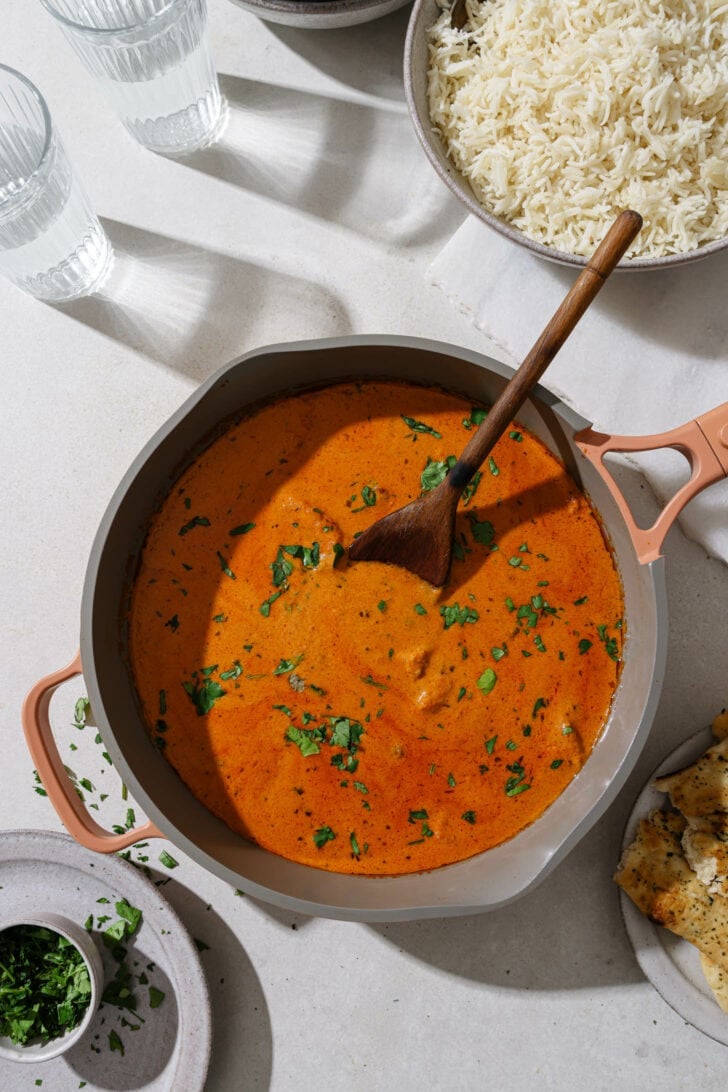
Want to save this post?
Enter your email below and get it sent straight to your inbox. Plus, get recipes & tips every week!
Navigation
How to Make Butter Chicken
History and Origins
Butter Chicken is not a dish our grandmothers made. In fact, it didn’t exist until the 1950’s, when Kundan Lal Gujral first created it at Moti Mahal restaurant in Delhi. (Others have claimed Butter Chicken’s invention, but I found Moti Mahal’s to be the most plausible.)
Murgh Makhani, as it was originally called, was born of necessity. Those days, without refrigeration, tandoori chicken would dry up in proximity to the hot tandoors. Kundan Lal thought to make use of it by serving it up in a butter gravy, not knowing his creation would one day become the poster dish of Indian cuisine. (Source)
More Restaurant-Famous Chicken Dishes: Chicken Jalfrezi, Chicken Biryani, Chicken Korma, and Chicken Karahi
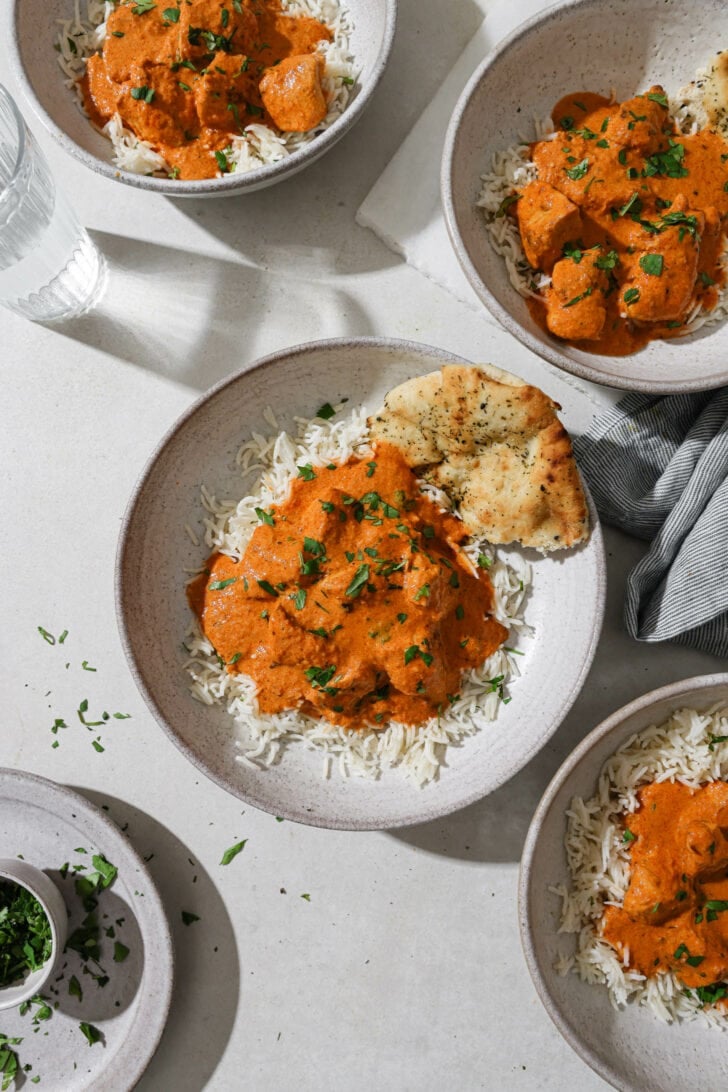
Where it is Today
Short answer: Everywhere!
- North Indian, Punjabi, and Pakistani Restaurants: Customer demand drives restaurant owners worldwide to feature it on their menu, which in turn continues to fuel its popularity. Usually, restaurants make it with a base gravy and/or makhani sauce, which they toss with chicken before topping it all with cream.
- Homes: Since Butter Chicken is an inherently industrialized, ‘restaurant-style’ dish, it’s a challenge to make a homemade one that tastes similar to restaurants. There is no homestyle, just-like-grandma’s Butter Chicken recipe to fall back on (grandma didn’t make it remember?). Premade masala seasonings, simmer sauces, and frozen meals are widespread. And the number of recipes, much like this one, continues to climb up.
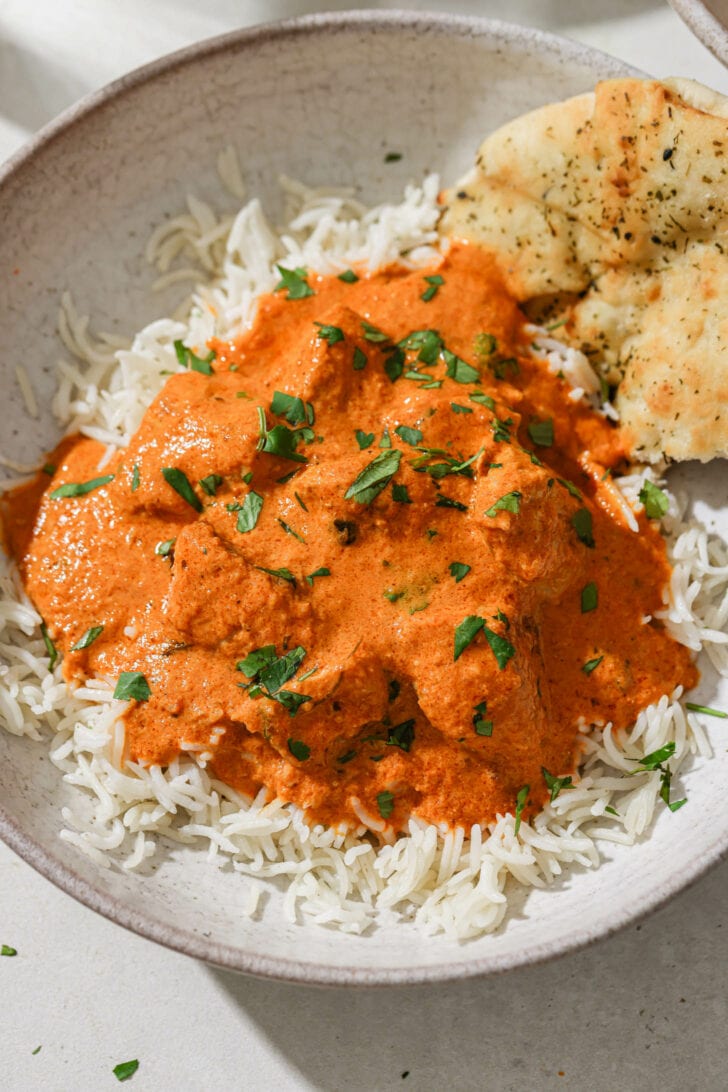
Recipe Testing
And while this is ‘yet another Butter Chicken recipe’, it comes after much toil and deliberation.
While recipe testing, two questions guided each of my decisions, and there were many, many decisions: “How can I make it simpler? and “How can I make it more restaurant-style?”. Here is what I learned about achieving a truly restaurant-style Butter Chicken at home:
Butter Chicken Truths
- You cannot use fresh tomatoes. This goes against my cooking instincts, as evidenced by almost every curry on the blog. But fresh tomatoes, unless picked when ripe, then boiled, peeled, and puréed, will not achieve that restaurant-style Butter Chicken sauce. They’ll make the sauce more tart, less smooth, and generally more like a tomato-based curry than Butter Chicken. Many recipes use store-bought tomato purée, but the purée lacks the vibrance I crave. The solution – purée canned tomatoes.
- Less is more. Much of recipe testing was carving out steps and ingredients. I removed green chili peppers, which add inconsistent heat when blended. Omitted turmeric powder, which gets lost in the sauce and creates unnecessary pungency. I experimented with cashews, didn’t find them essential. Tried adding whole spices, found them to be distracting and cumbersome. The recipe became incrementally better the more I pared it down, eventually getting closer to the original Moti Mahal recipe. (Kundan Lal immigrated from Peshawar, where food was much simpler, with less spices, than in India.)
- Don’t hold back. A lesson I didn’t want to learn, but had to. Use the butter, use the sugar, use the cream. This recipe is designed to impress. It’s Butter Chicken. Let it be so.
Other Butter Chicken recipes I’ve tried: Dishoom’s “Chicken Ruby”, Two Sleevers’ Viral Butter Chicken, Get Curried’s Youtube Recipe, and others.
Books I’ve consulted: On the Butter Chicken Trail (Moti Mahal’s official cookbook), written by Kundan Lal’s grandson Monish Gujral, Anita Jaisinghani’s Masala, Colleen Taylor Sen’s Feasts and Fasts: A History of Food in India, and others.
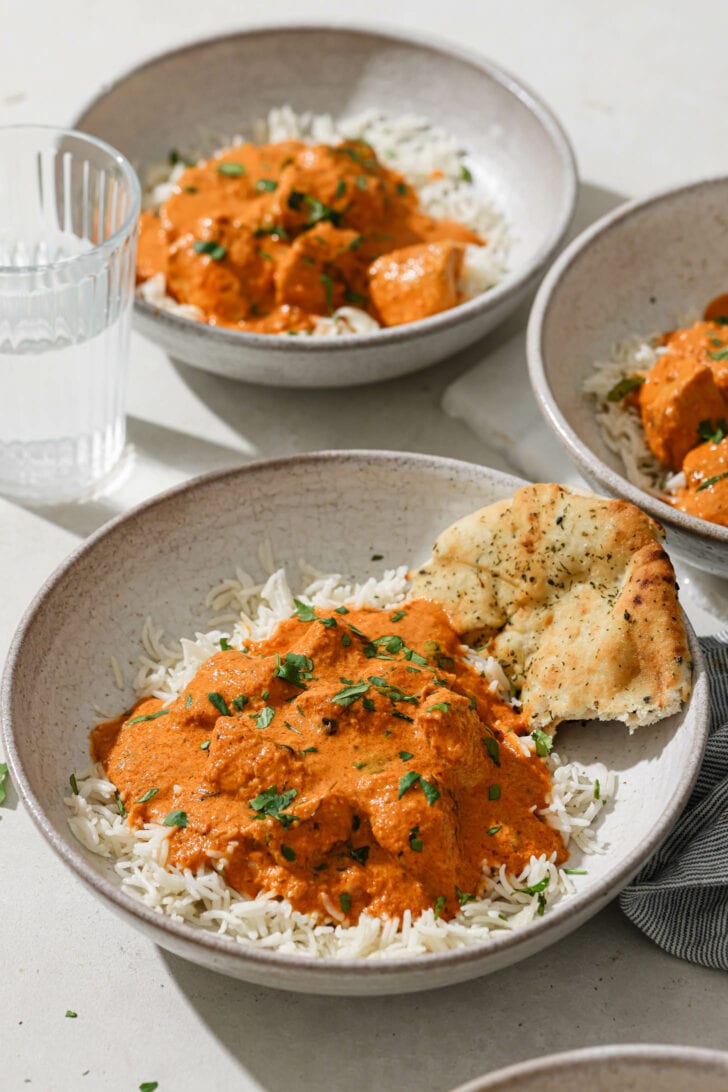
What is the difference between Butter Chicken and Chicken Tikka Masala?
Given restaurants’ priority on efficiency, most are likely using the same gravies and sauces for both. Here’s what I’ve concluded after speaking with several Houston restaurant owners and perusing various cookbooks, including Moti Mahal’s cookbook, which deems Chicken Tikka Masala a ‘derivative of Butter Chicken’.
| Butter Chicken | Chicken Tikka Masala |
|---|---|
| milder, but still complex sauce | complex, more intense sauce |
| creamy, buttery flavor | creamy, tomatoey flavor |
| less spicy | more spicy |
| chicken pieces not necessarily charred | chicken pieces from chicken tikka, which implies char |
| sometimes uses cashews | no cashews |
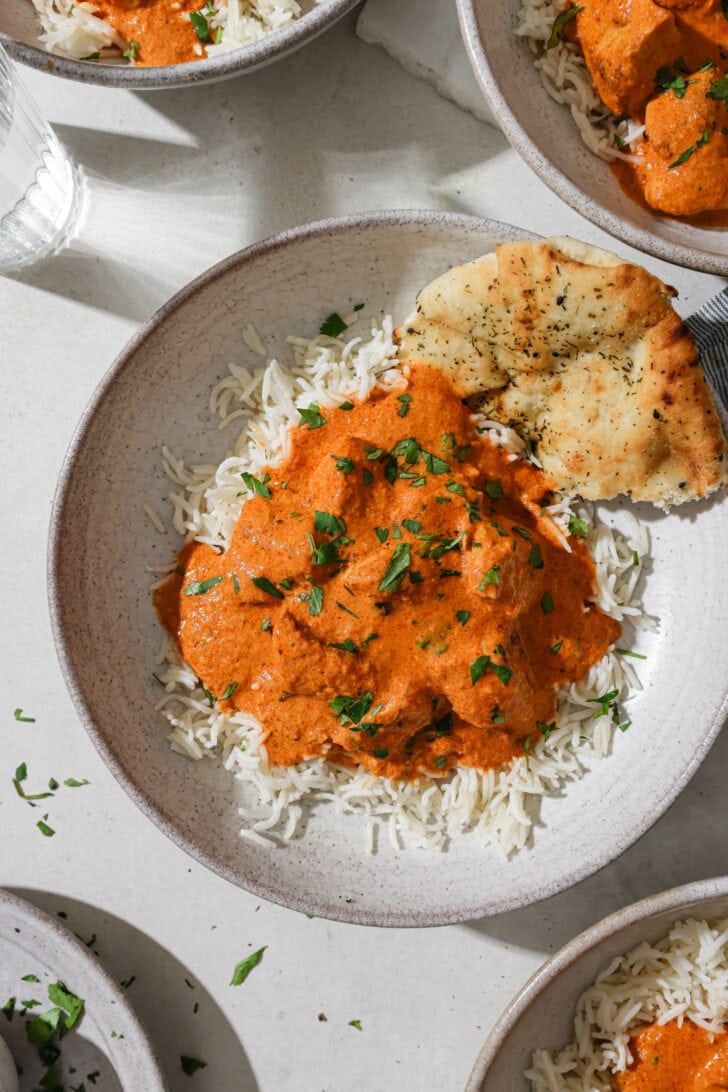
Ingredients
Here are notes on some of the ingredients. Each of the ingredients and their quantities is intentional. If you have any questions about the ingredients or their substitutes, please free to ask in the comments.
For the Marinade
On using store-bought Tandoori Masala: My Instant Pot Butter Chicken recipe, which I published 6 years ago, requires a full 1-2 tbsp of store-bought Tandoori Masala for its marinade. Somewhere along the way, I developed an aversion to large quantities of Tandoori Masala powders and found them quite noticeable in the final product. For this recipe, I tried marinating the chicken in 1 tbsp of store-bought Tandoori Masala and yet again, didn’t enjoy the flavor as much as I do the with the DIY blend I created for this recipe. I’d suggest using a small quantity to enhance the flavors (1/4-1/2 tsp) rather than using it entirely in place of the ground spices in the marinade.
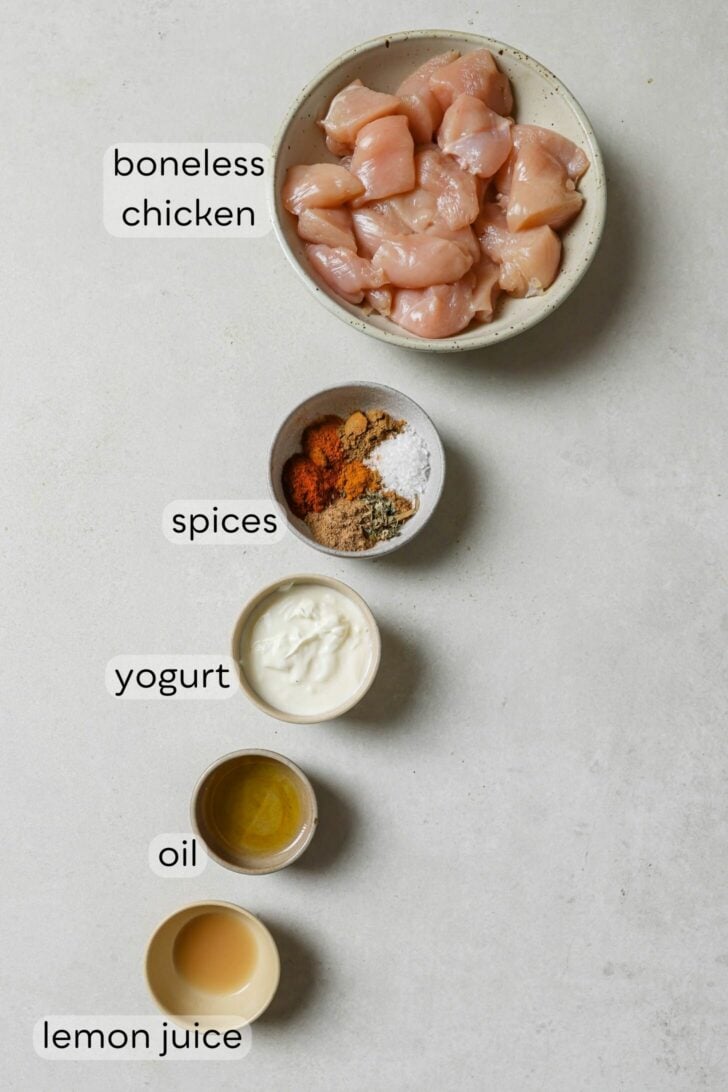
- Plain, whole-milk yogurt, preferably Greek: South Asian Kebab recipes often called for ‘hung’ or strained yogurt, essentially Greek yogurt. The thicker yogurt coats the meat better (not as runny) and has a stronger flavor. Using too much adds unnecessary tang to the sauce.
- Ground Spices aka a quick Tandoori Marinade: Mild Kashmiri chili powder or paprika for color, red chili powder or cayenne pepper, coriander powder, cumin powder, turmeric powder, and garam masala.
- Lemon or lime juice: Tenderizes and balances out the spices with vibrant flavor.
- Garlic paste (optional): I have never seen a Butter Chicken marinade without garlic, but I kept it optional since there is plenty of garlic within the sauce. I don’t care to add garlic/ginger to my Chicken Biryani marinade either.
Chicken
- Boneless Chicken: I’ve most often tested this recipe with chicken breast to ensure it stays tender. Feel free to use chicken thighs or tenders (the little strips of meat attached to the underside of the chicken breastbone).
- Quantity: You may increase chicken up to 600g without making changes to the marinade, save for an extra dash of salt.
How is the chicken at restaurants so tender?
Restaurants often use a tenderizer within the chicken marinade, which makes it extra tender, and sometimes a little extra chewy/artificial-tasting. If you’re interested in tenderizing the chicken breast, use 1 tsp papaya paste in the chicken marinade. (I use this trick in my Seekh Kebab).
For the Butter Chicken Masala
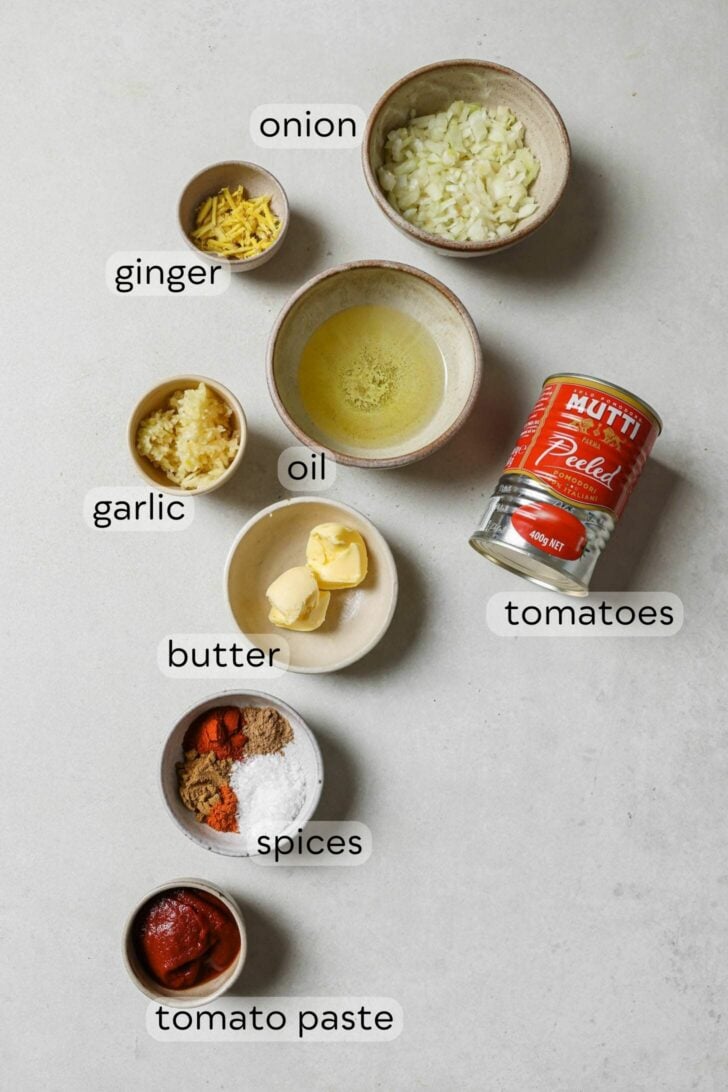
- Whole peeled tomatoes: Canned whole tomatoes are my top choice for making butter chicken. They lend uniformity in flavor while keeping the sauce fresh and vibrant. Substitutes:
- Fresh Tomatoes: Use 3 ripe tomatoes (~300g). Boil for about 20 minutes, until they’re soft and the skin comes off easily. This helps mute the tart flavors and intensify the tomatoey flavors. Remove the skin, then purée and use as directed.
- Tomato purée: Not to be confused with tomato sauce or crushed tomato. Sub ⅔ cup (170g) store-bought tomato purée.
- Salted butter or ghee: For cooking the chicken and adding flavor while you’re at it.
- Onion: A small amount adds body to sauce. I use a food processor to chop the aromatics up. You’ll be needing it to purée the tomatoes and the masala, so I suggest putting it to use. Use the pulse function to chop the onion, but be careful not to blend or it’ll release water and become harder to brown.
- Ground Spices: Kashmiri chili powder or paprika (again, for color), cumin powder, coriander powder, and red chili powder or cayenne for heat.
- Tomato paste: Deepens the tomatoey flavors and adds color.
After Blending
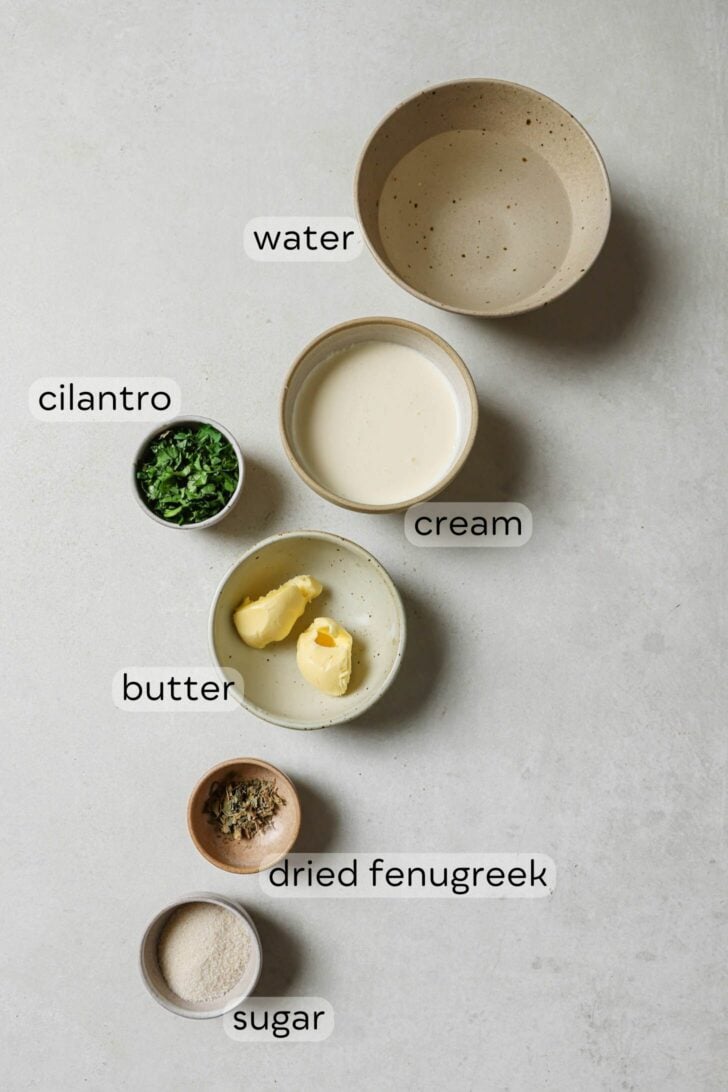
- Water: For thinning out the sauce.
- Sugar: Offsets the tart flavors and adds complexity to the sauce. The amount I’ve given may seem like a lot, but it only makes it subtly sweet. Feel free to adjust to taste.
- Heavy whipping cream: Essential to give it that signature creamy mouthfeel, but too much will dilute the flavors.
- Substitutes: Half and half, lactose-free or dairy-free soy or coconut cream with varied results.
- Salted butter: A knob at the end to give it a rich finish.
- Dried fenugreek leaves (sukhi or Kasuri methi): An essential for authentic Butter Chicken. Available at Indo-Pak grocery stores or online, not at general grocery stores. If you can’t find it, omit and substitute with more cilantro. Crush the methi between the palms of your hands to help extract its flavor.
- Cilantro: I love a good helping of cilantro to create texture and add fresh, contrasting flavor.
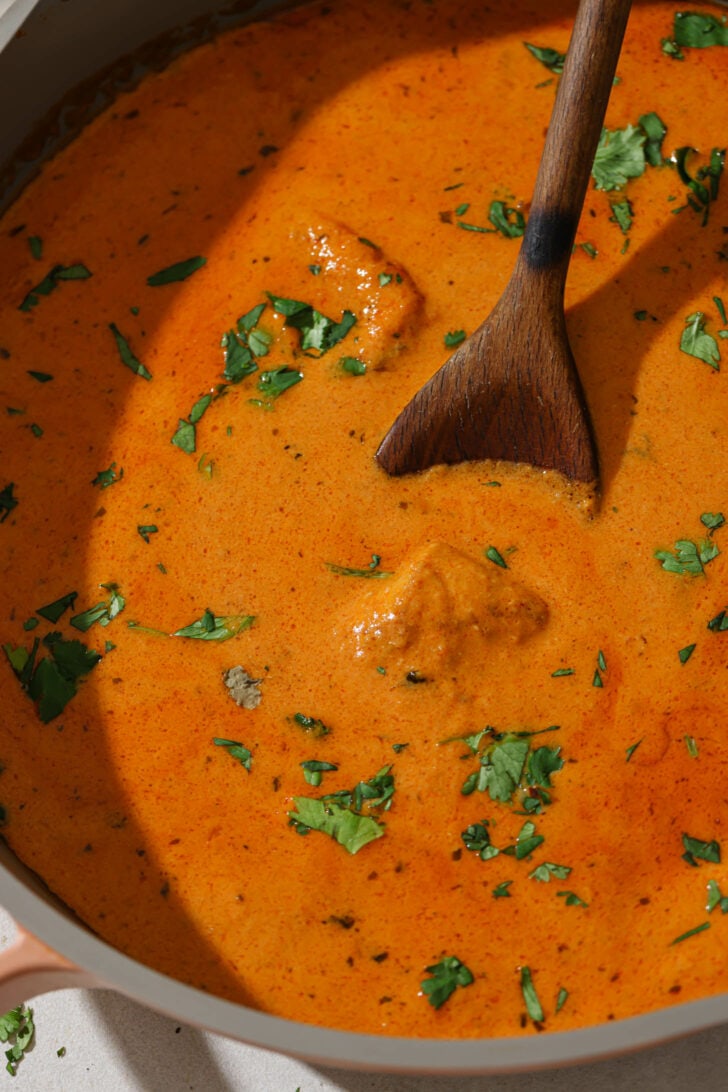
How to make Butter Chicken – Read for Tips!
Marinate Chicken
- Marinate chicken: Of course, marinating for longer is better. But I’ve made it plenty of times immediately after marinating with little noticeable change.
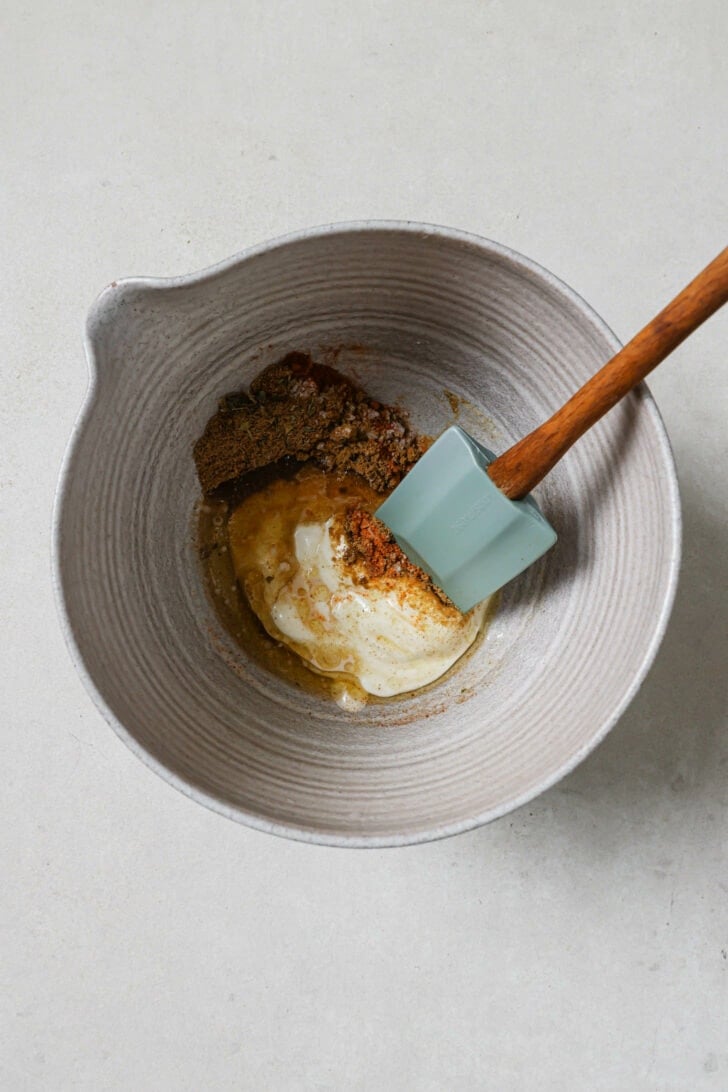
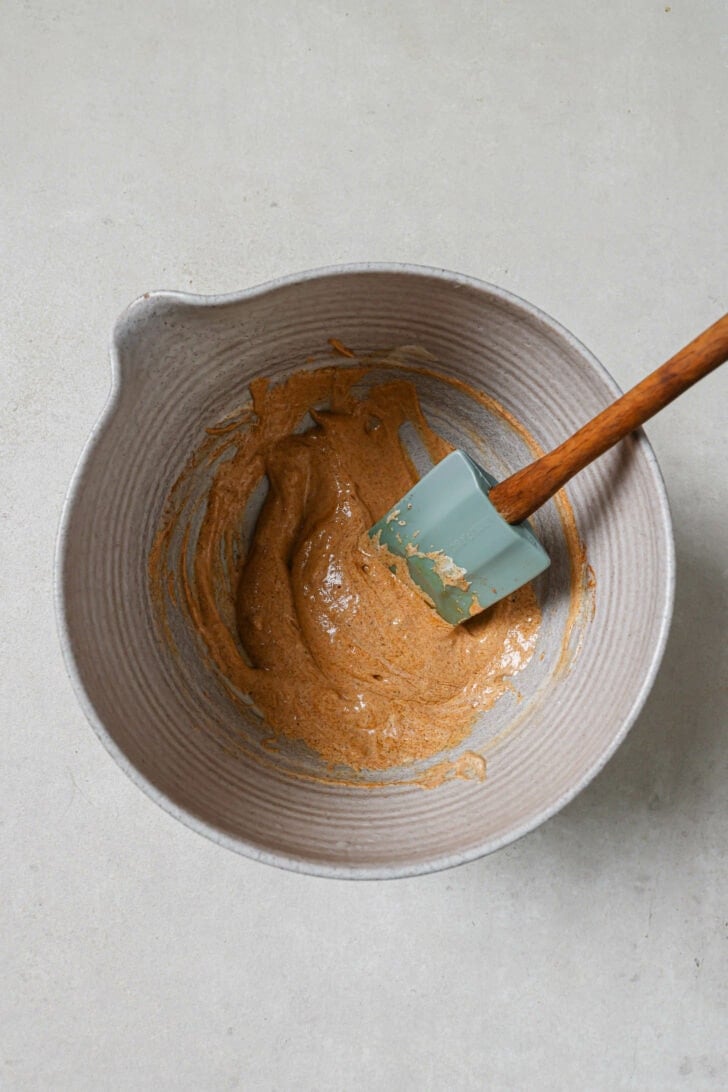
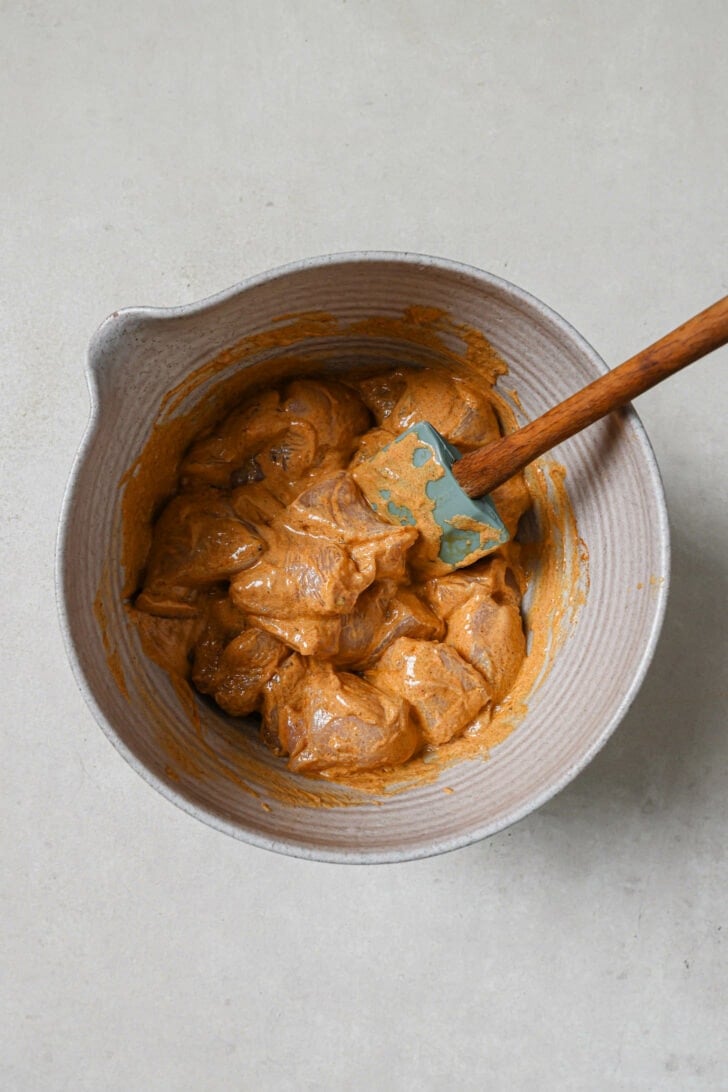
Prepare Tomatoes
- Purée tomatoes: Drain the whole tomatoes to remove excess liquid. Using all the liquid will dilute the other flavors.
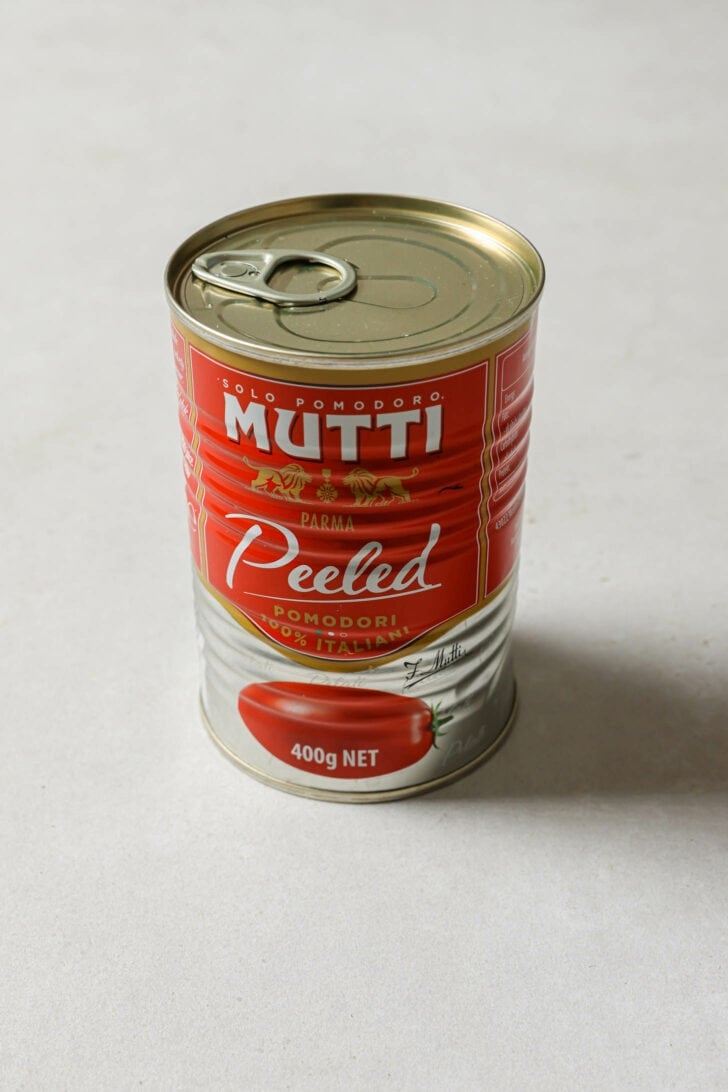
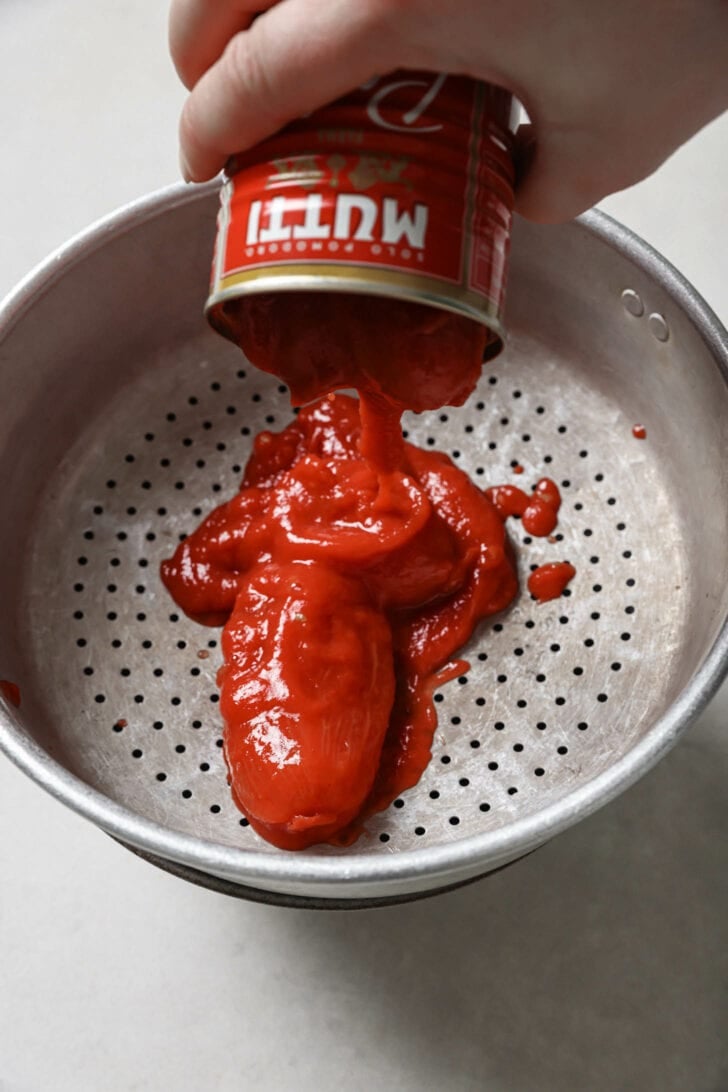
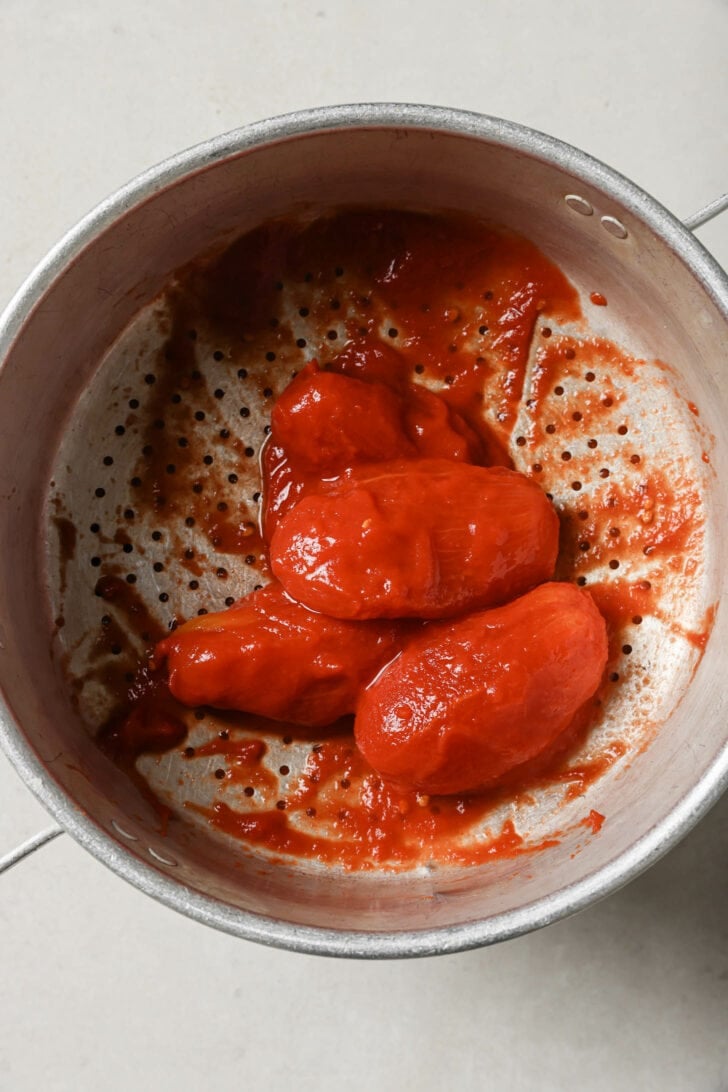
- Blend these in a food processor or blender and set aside.
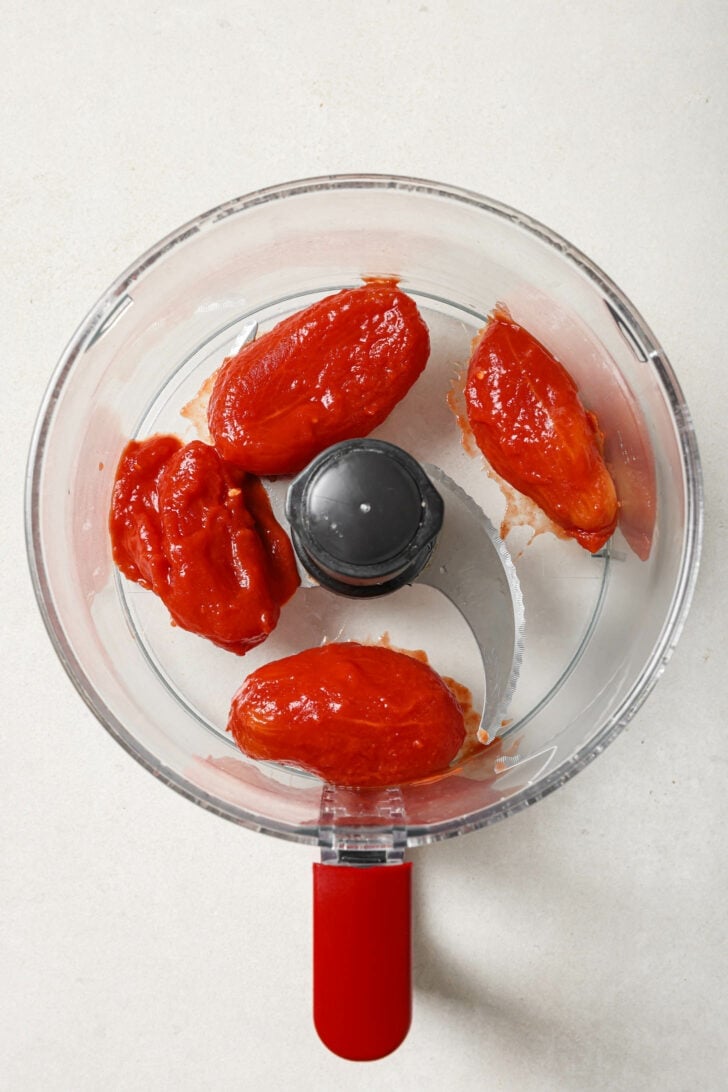
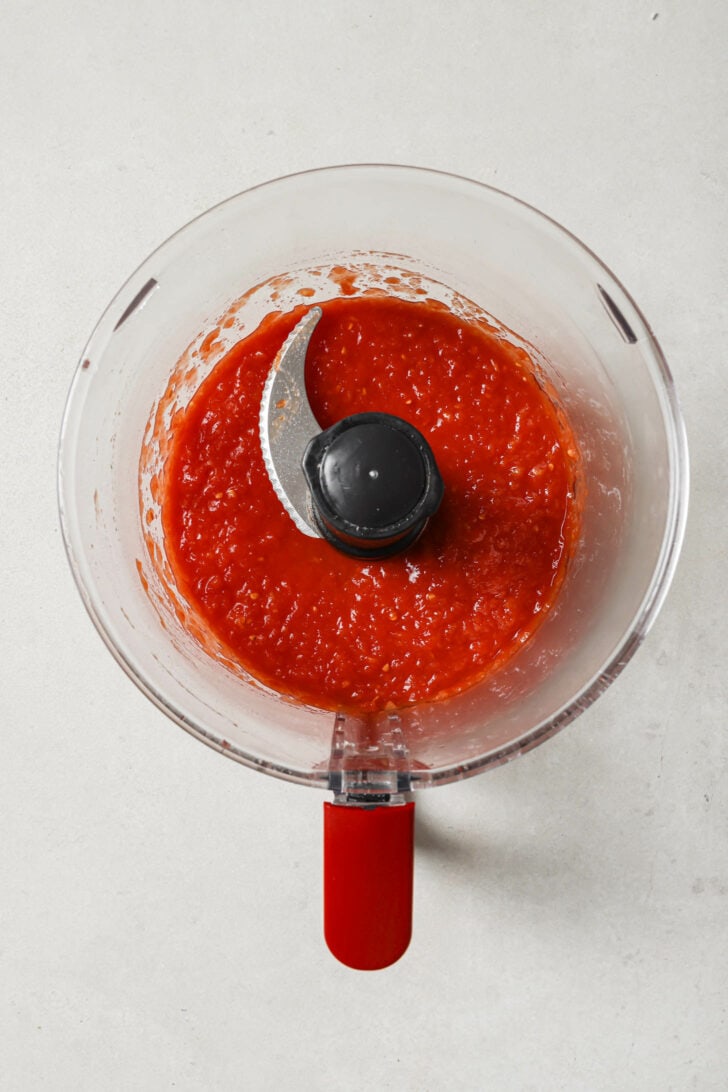
Cook Chicken
Type of pan: For ease, I recommend using a nonstick pan. The chicken sears better, and you don’t have to worry about the butter browning too much. That said, this recipe is designed to work just as well with a stainless steel pan – adding oil along with butter helps prevent the butter from browning too much. Note: If you’re using ghee, you don’t need the accompanying oil to sear the chicken. (Ghee has a higher smoke point so it won’t brown.)
- Cook Chicken: The goal is to sear and seal in moisture, not to cook it fully. If your pan is wide-bottomed, you can squeeze in all the chicken pieces. If not, you may have to do this in 2 batches. Adding too much chicken pools up moisture and doesn’t allow charring. Also, don’t worry too much about getting it perfectly charred. The charred bits are nice, but as we covered earlier, not essential in butter chicken.
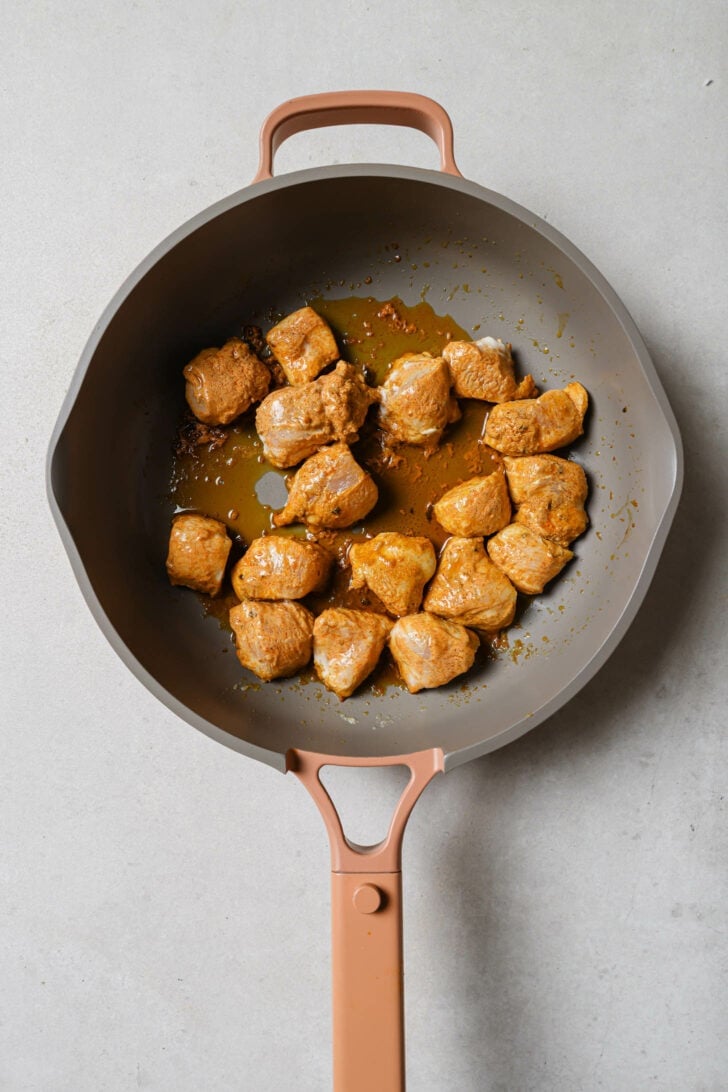
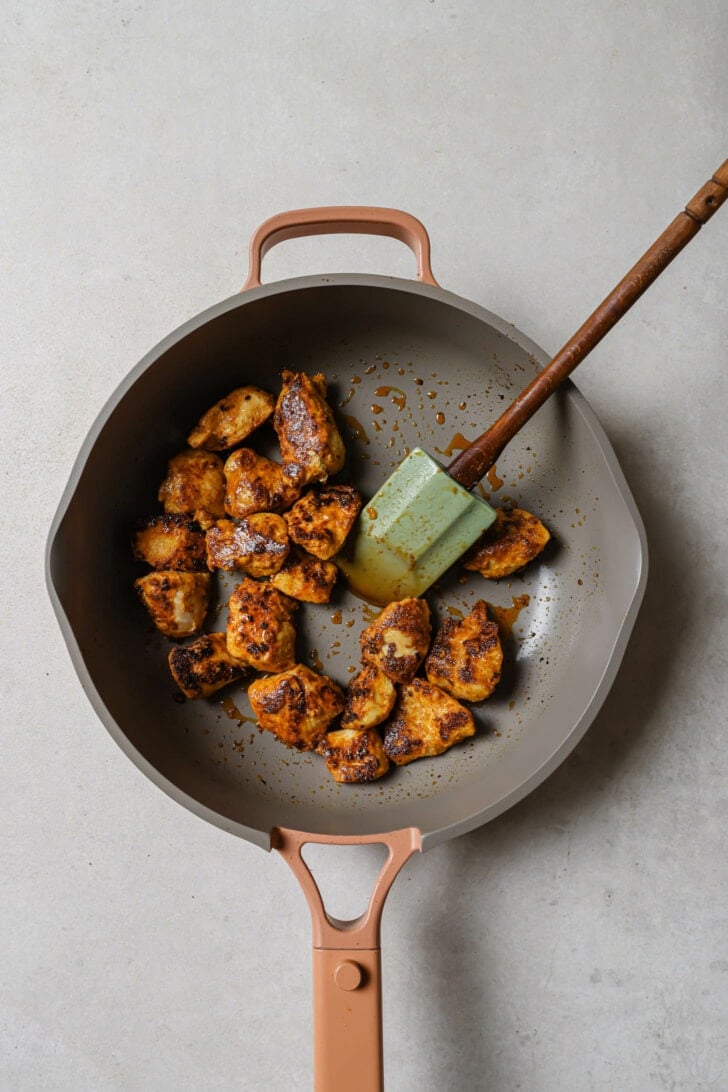
Oven Broiling Method: For a stronger char, you can broil the chicken in your oven.
- Preheat your broiler to High/550°F.
- Move the baking rack close to the heat source (mine is at the top of the oven).
- Line the bottom of a baking sheet with aluminum foil. If you have one, place wire rack on top. Arrange the chicken pieces so they’re not touching. Broil for 8-10 minutes, until lightly charred on top. I rotate my tray mid-way.
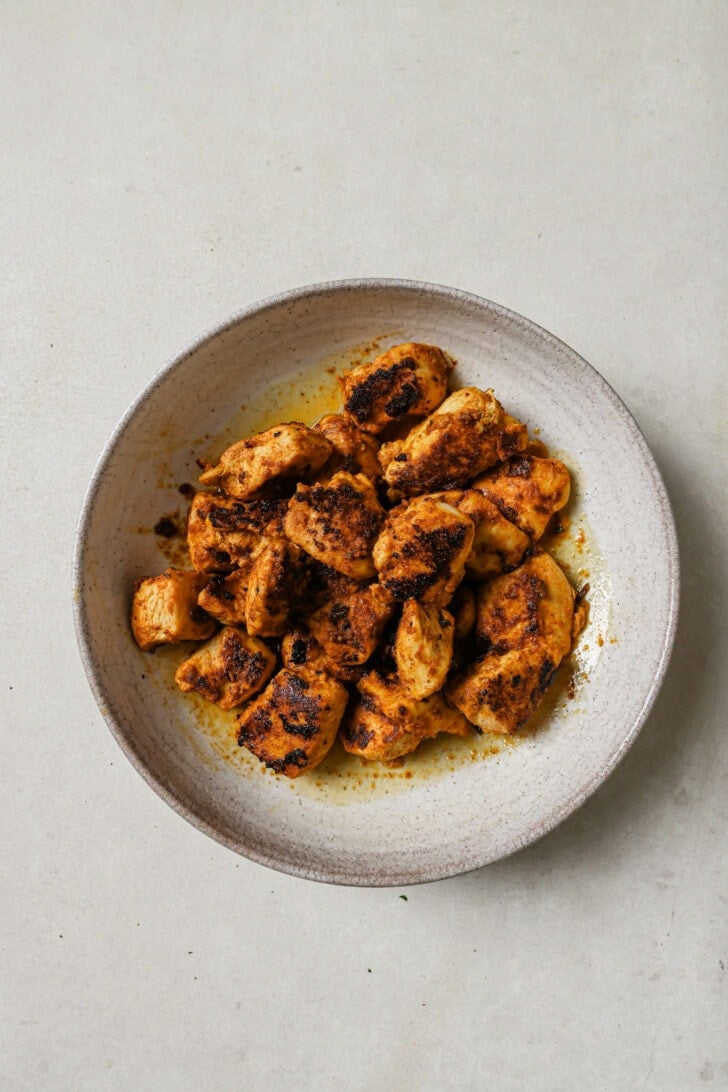
Prepare Masala
- Brown onions: Here’s the next step in building flavor. Brown the onions, garlic and ginger in the flavorful remnants. Deglaze, removing any stuck bits. Reduce the heat, then add the ground spices along with the salt and allow them to bloom.
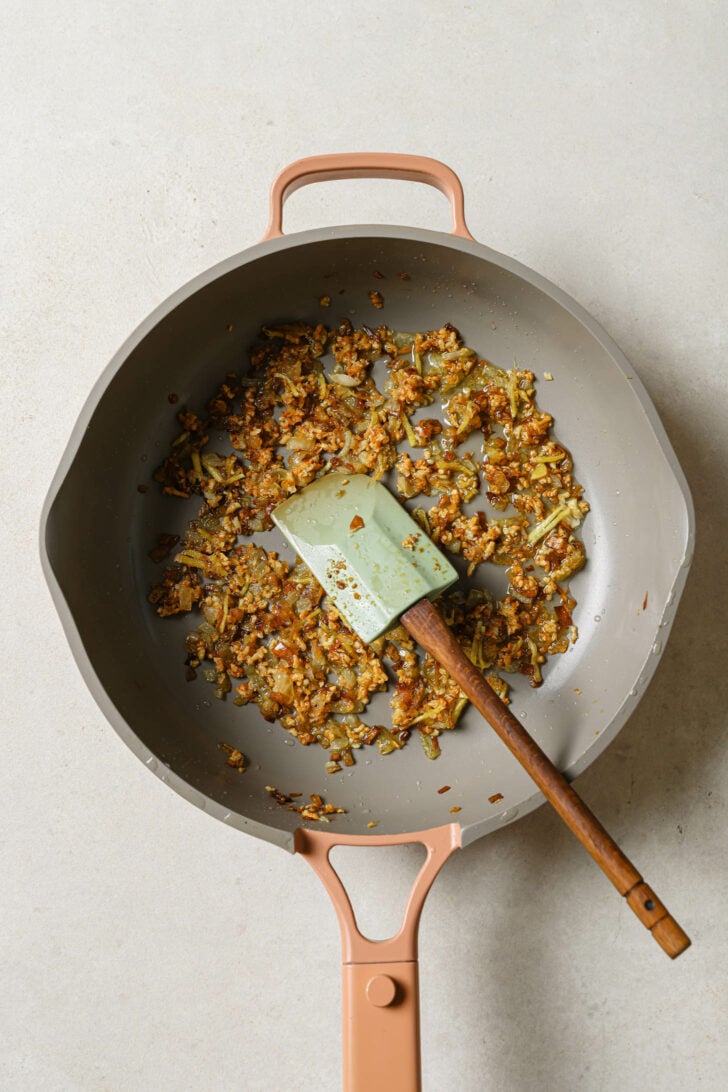
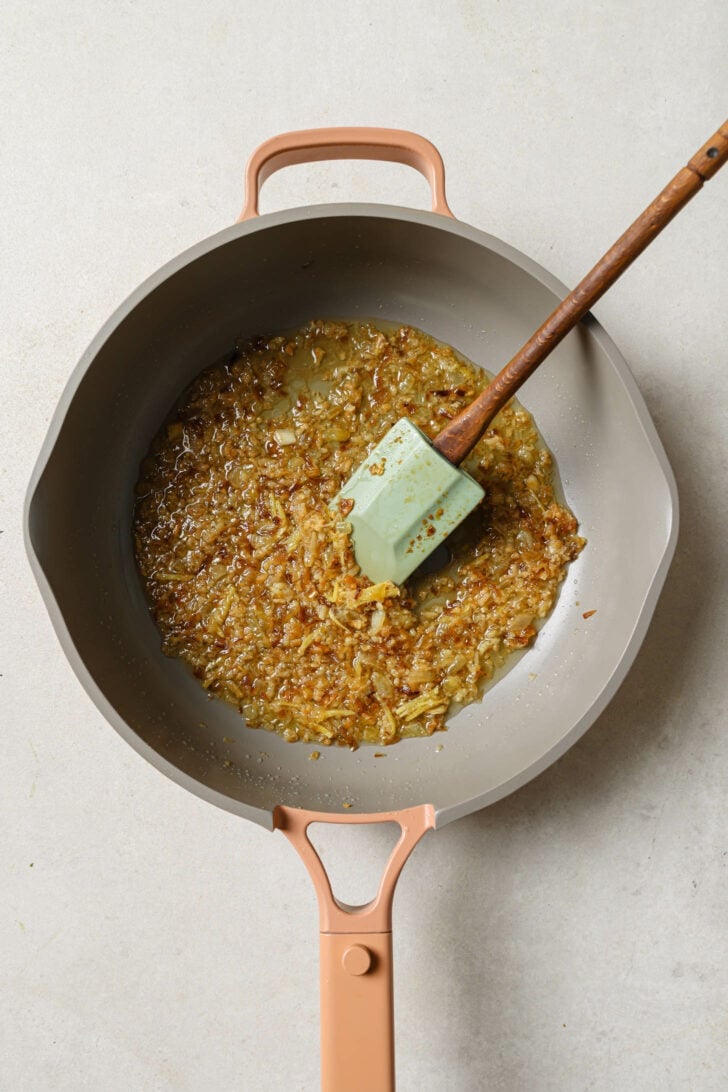
- Reduce tomato sauce: Add the tomato paste and puréed tomatoes and increase the heat. This is where the South Asian technique of Bhunai comes in. Bhunai is stir-frying/sauteing for a fair amount of time to ‘cook out’ the ingredients, extracting their flavor while you’re at it. It won’t take long, but you want to cook this masala until the tomatoes reduce and the oil starts to separate.
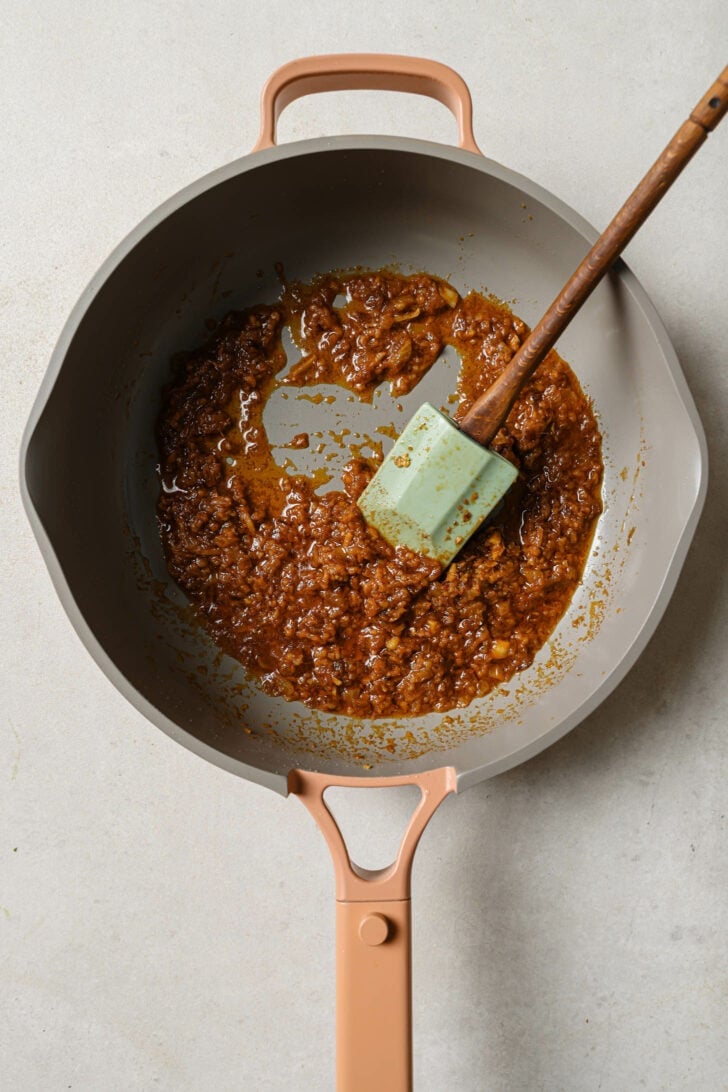
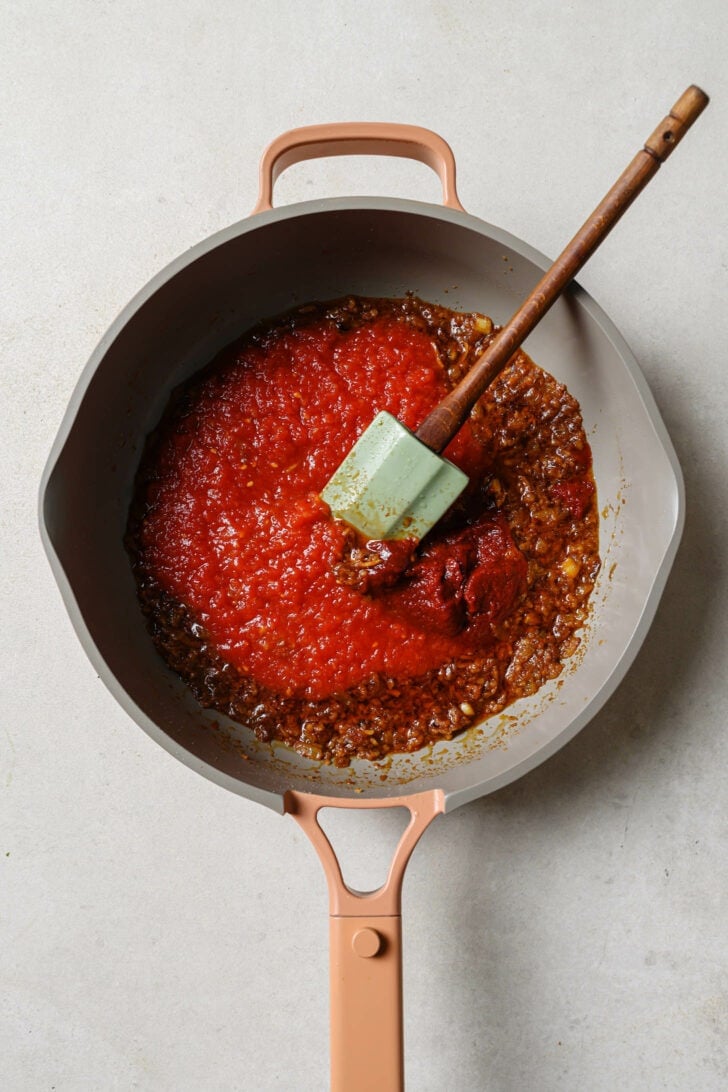
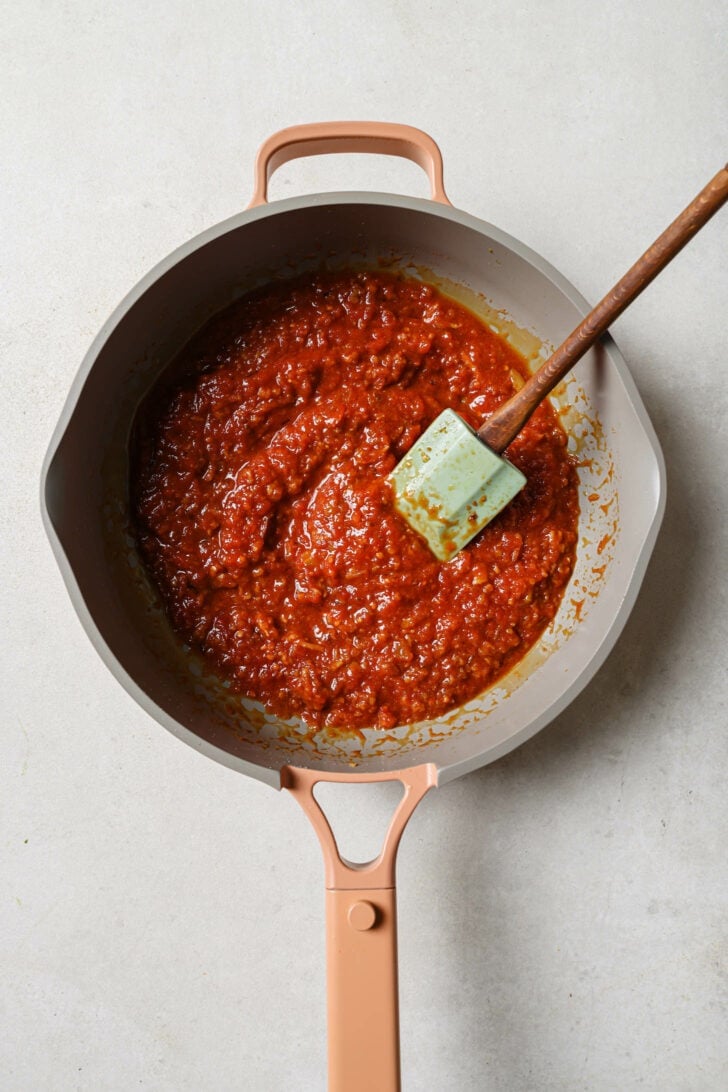
Blend Masala
- Blend Sauce: Transfer the masala to a food processor or blender – I prefer the former. (A rubber spatula helps wipe the pan easily when removing the sauce.) Blend the sauce and place it back into the pan.
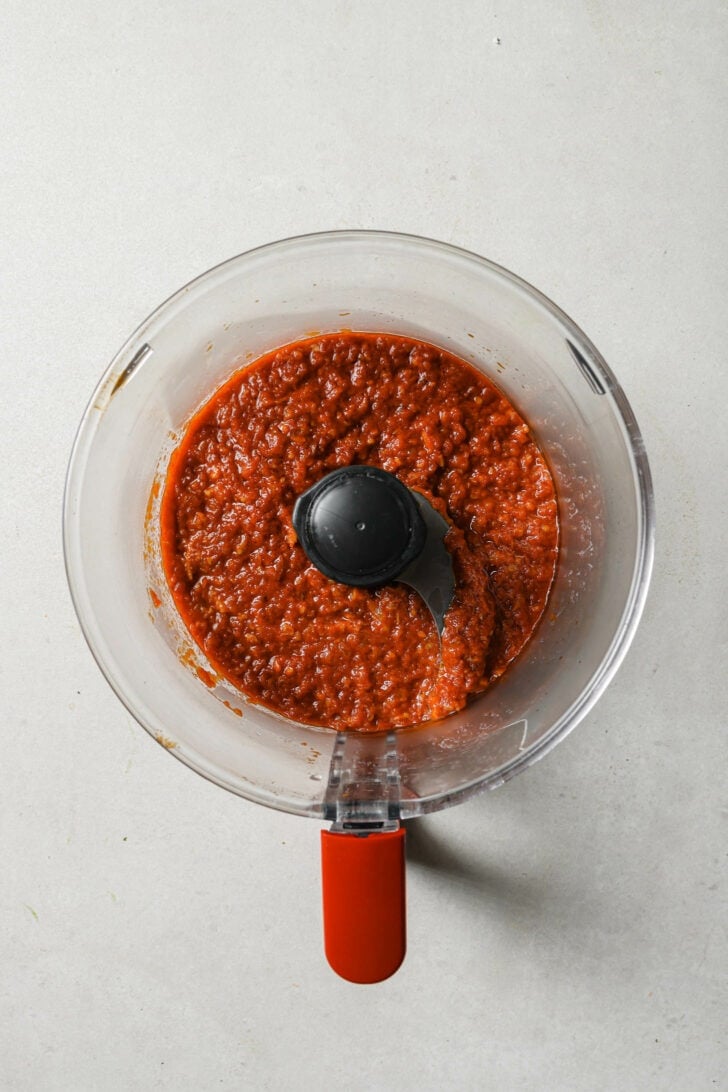
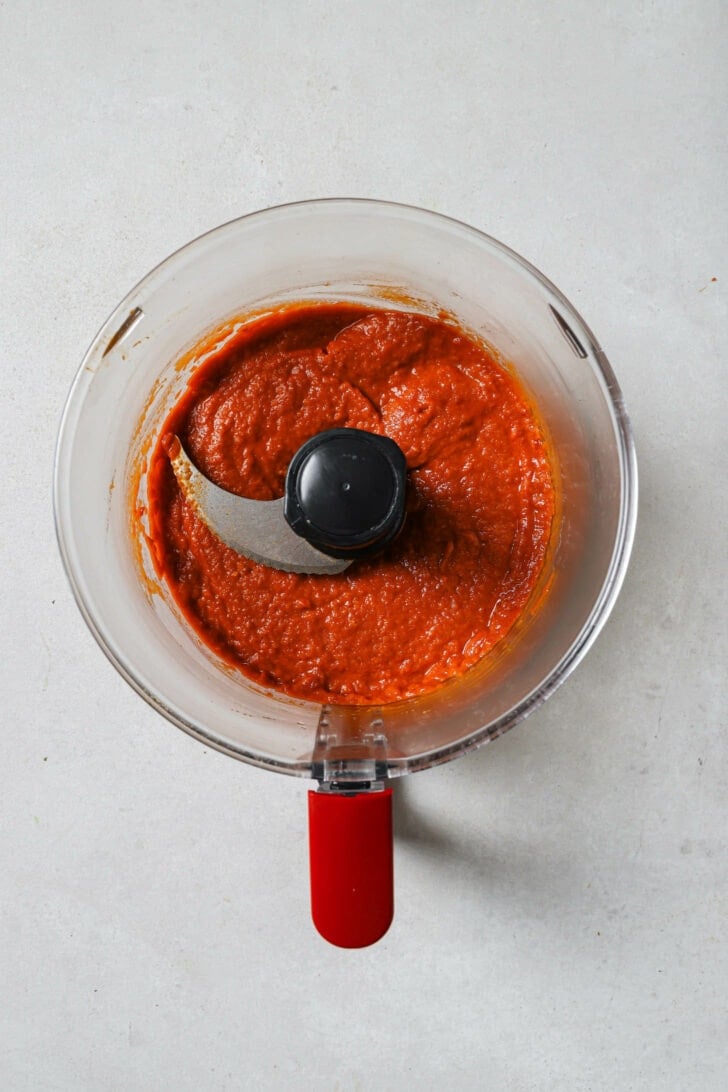
Simmer Together
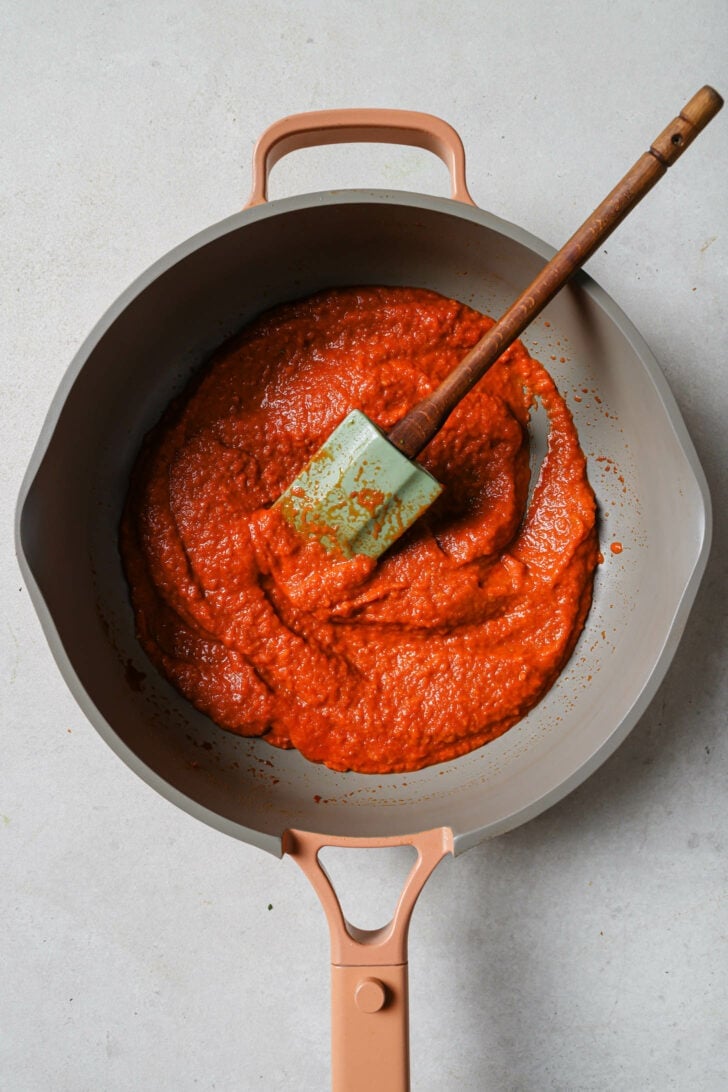
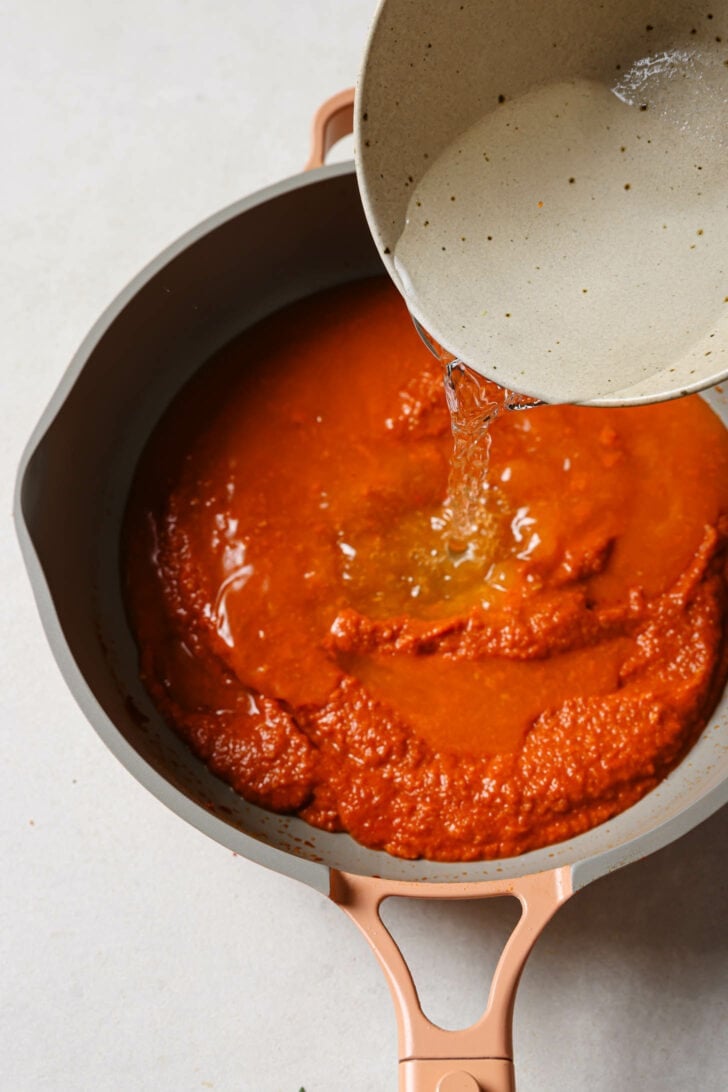
- Add water and sugar: It’ll be a tad sweet at first, but will mellow down as it settles into the sauce.
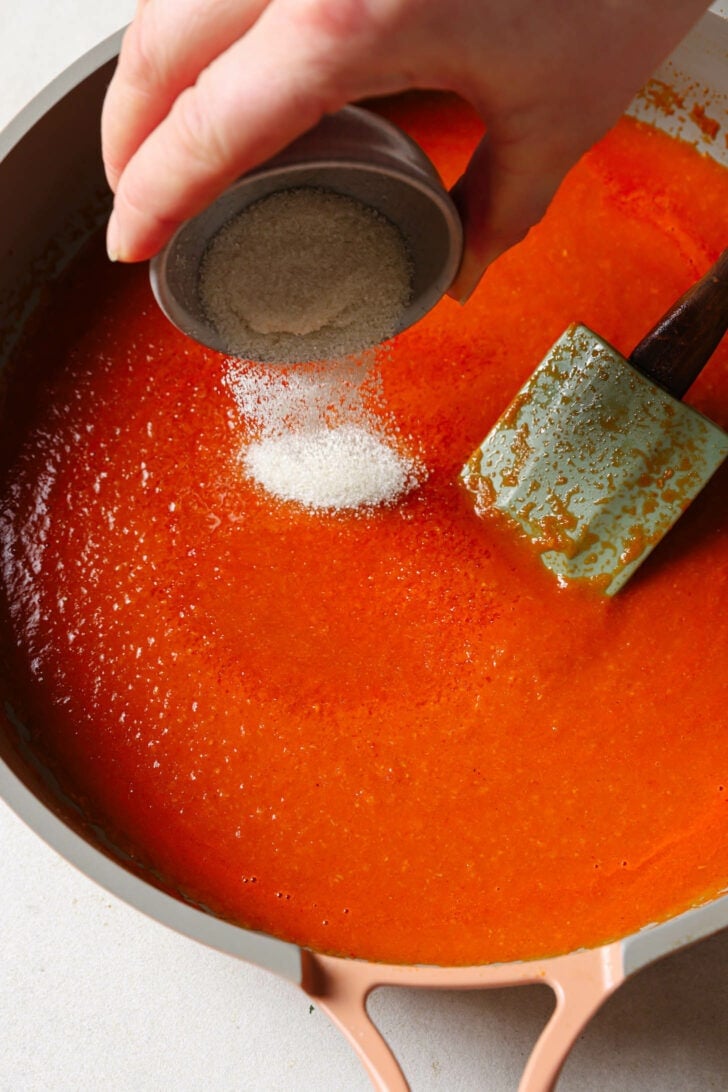
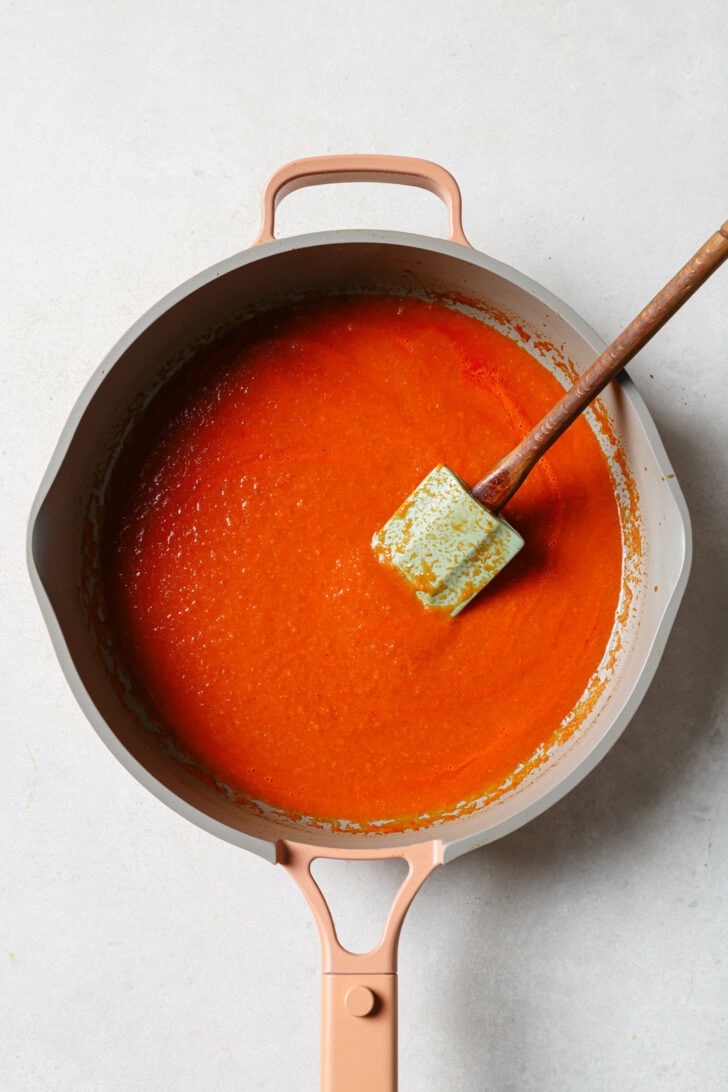
- Simmer with chicken: Add the prepared chicken with its juices and stir. This is another essential flavor builder, as the chicken juices meld into the masala. Cover and simmer, stirring once in between, until the chicken is tender and the oil rises to the top.
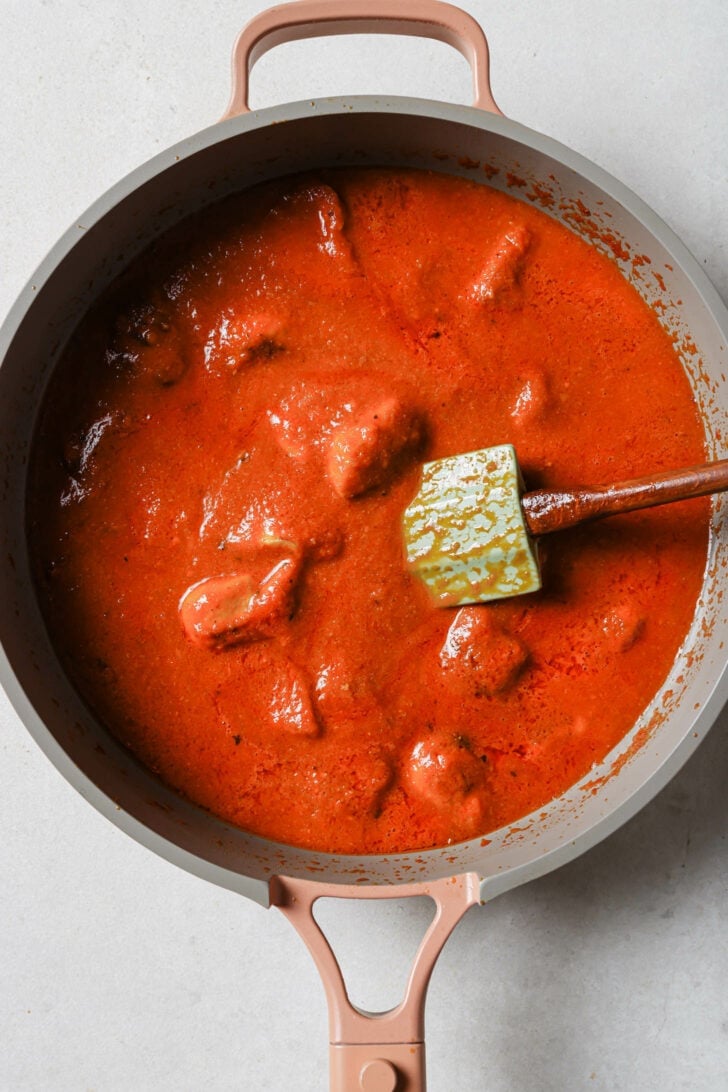
Add Finishing Ingredients
- Cream: Pour in cream no earlier than right before serving. Don’t boil for too long or it’ll lose its richness. If you want to make the sauce thinner, use water instead of heavy cream. Too much heavy whipping cream will make the curry heavy and and dilute the flavors.
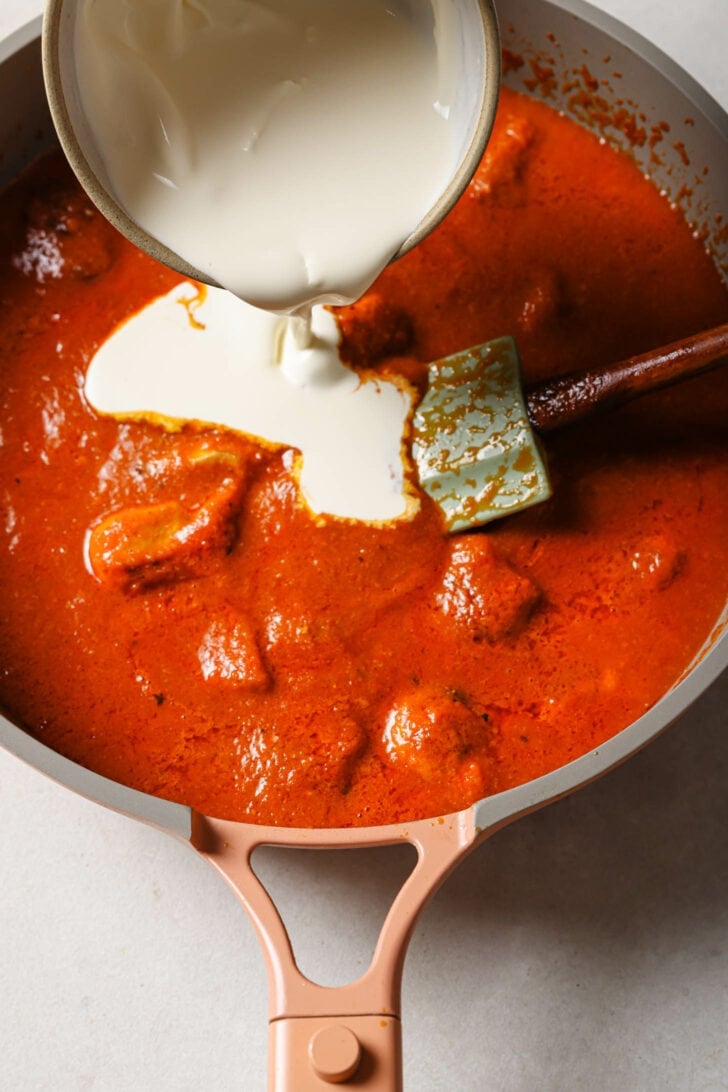
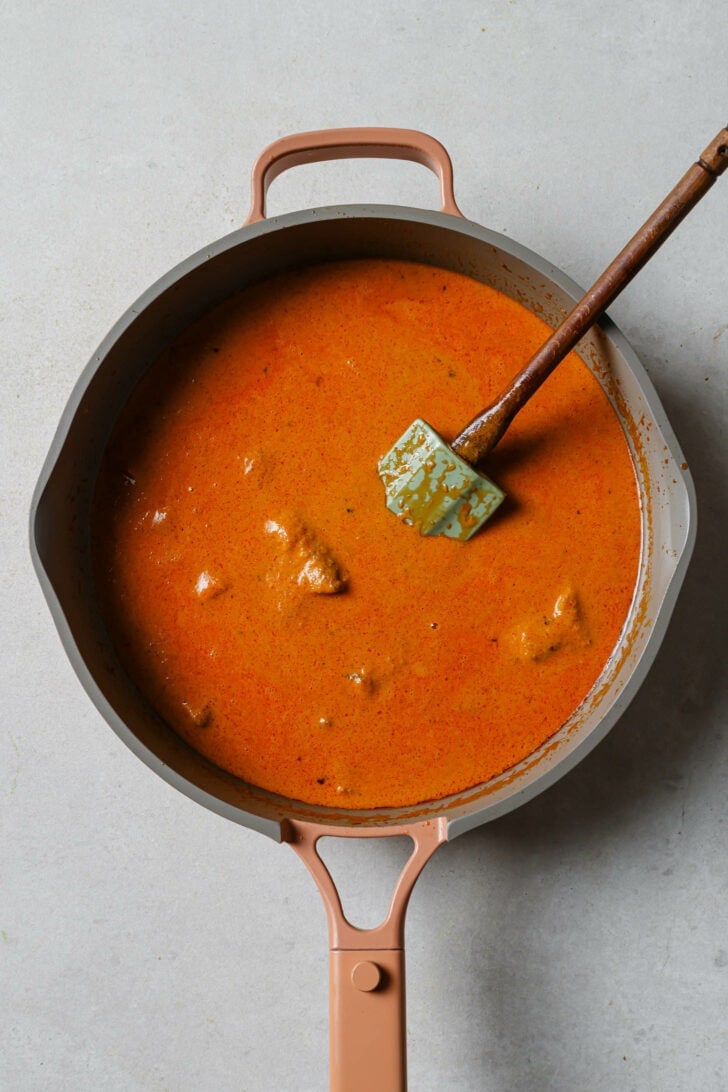
- Garnish: Sprinkle in the dried fenugreek leaves (methi) and stir in the butter. Have a taste here, you’ll find the sauce is mind-blowing! Finish off with cilantro.
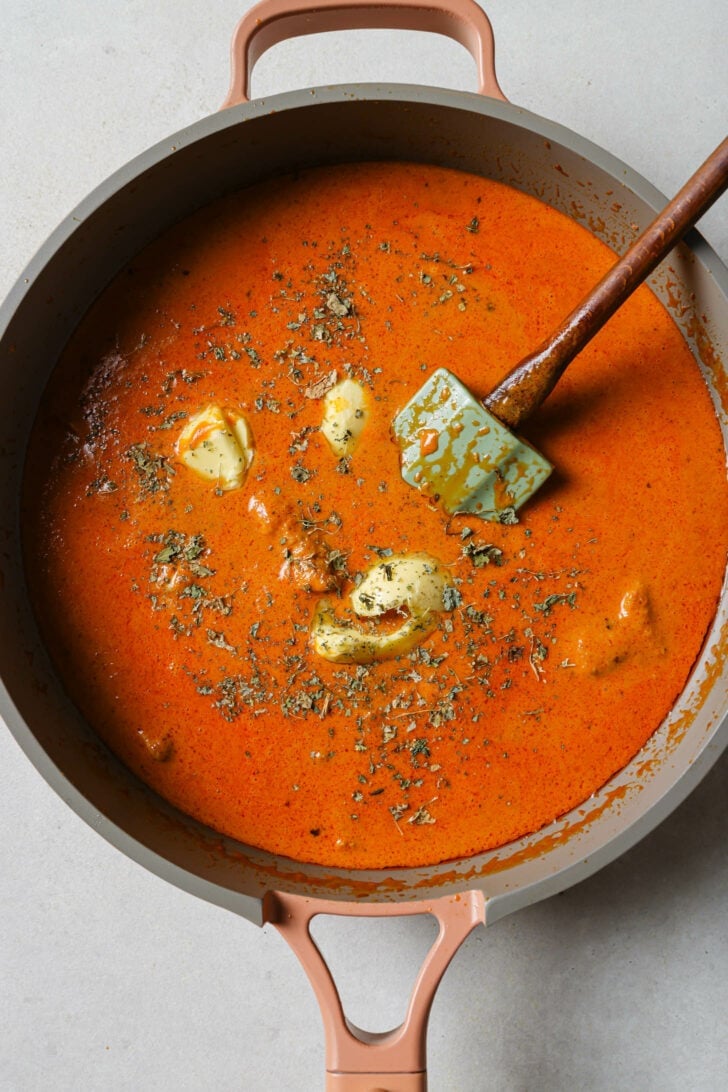
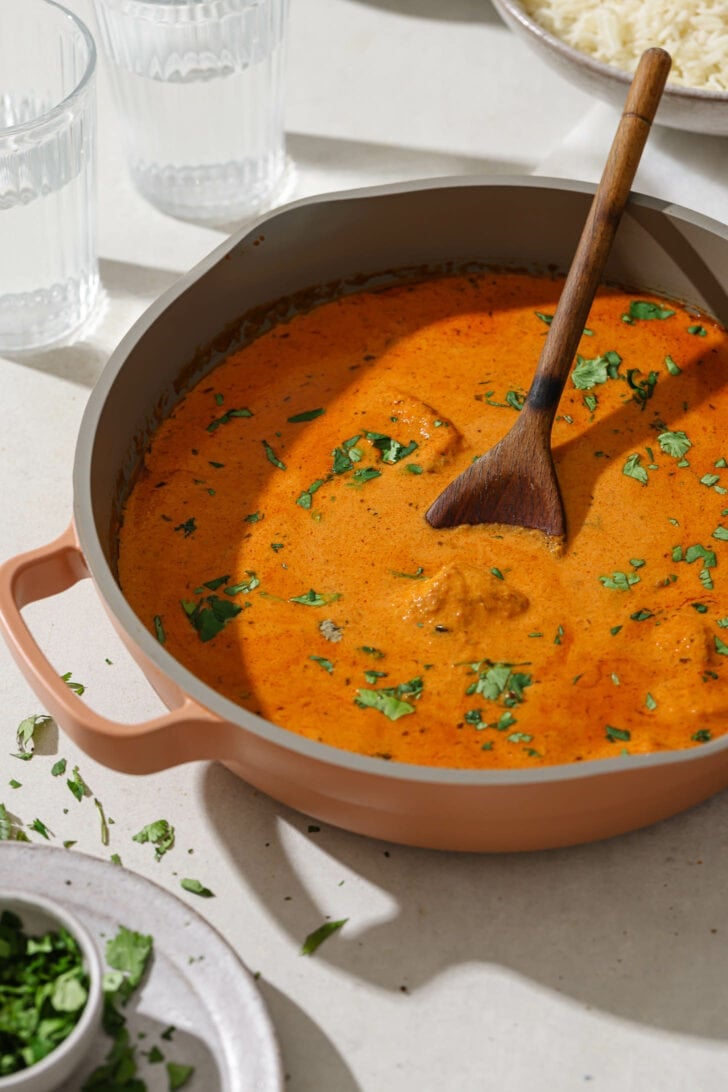
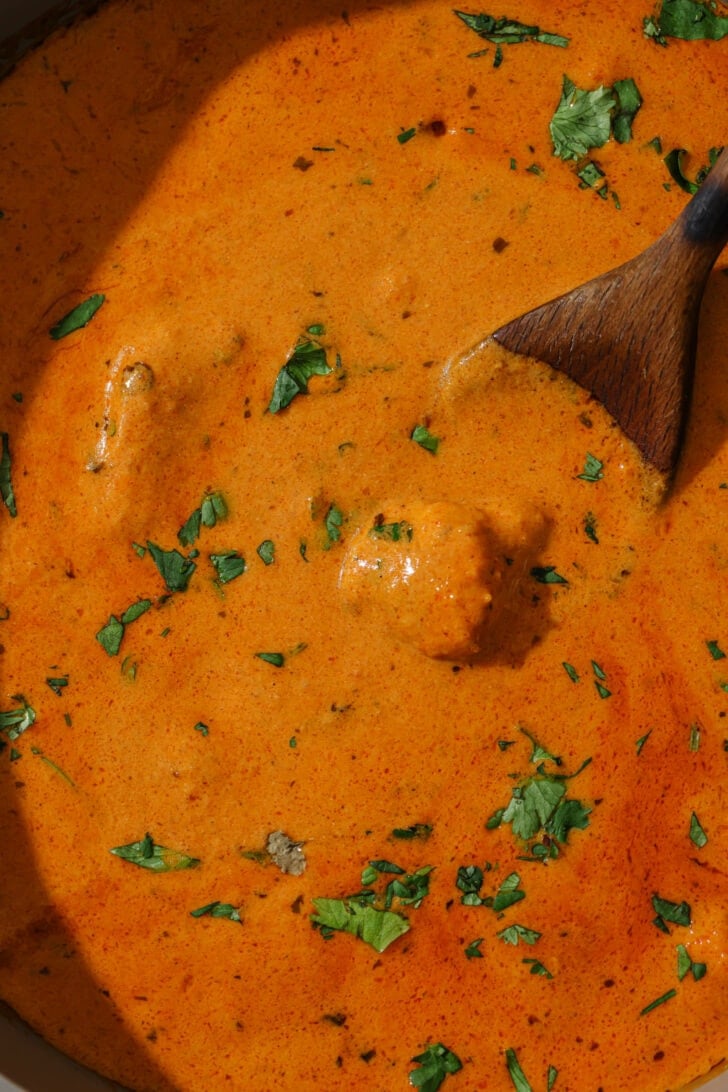
What to Serve with Butter Chicken
Basmati rice and Naan (buttered or garlic) are the classic restaurant pairings. As you probably know, South Asians generally don’t make their own naan, but usually buy it frozen.
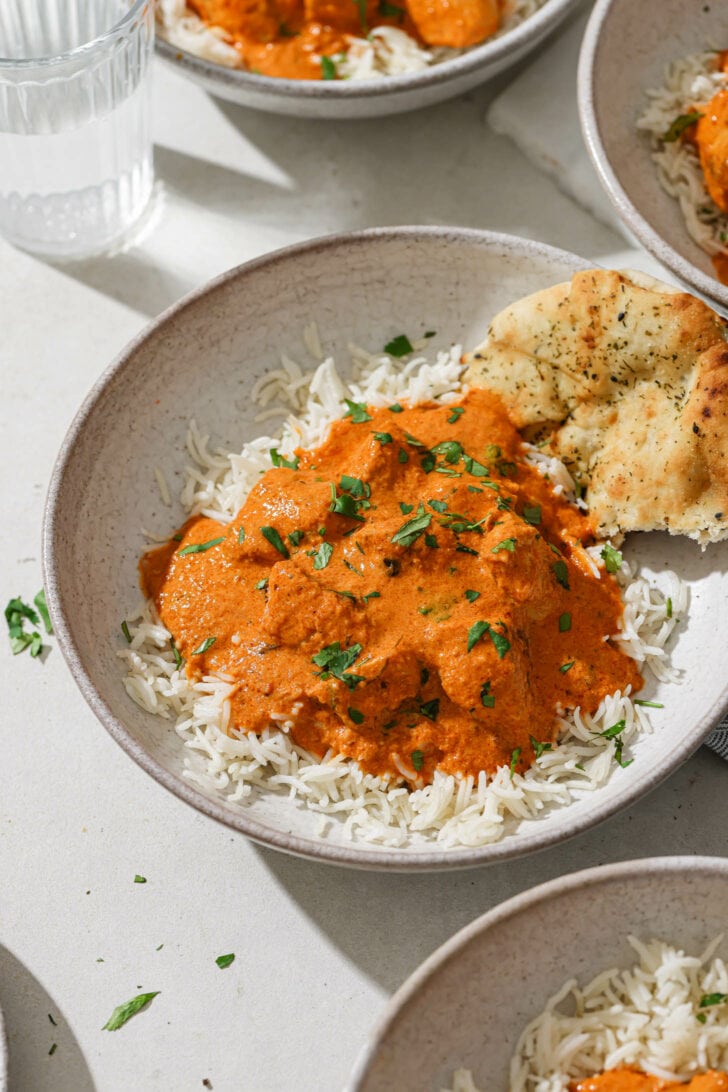
How to Store and Re-heat
- Store in the fridge for 2-3 days. You can also freeze for up to 6 weeks.
- If making ahead, please don’t add the cream until right before serving.
- Ideally, reheat on the stovetop with a splash of water. Microwaving is also perfectly acceptable here.
Leftovers? The possibilities are endless! You have protein + a built in sauce. Shred up the chicken and make wraps with pickled red onion, use as filling for buns or puff pastries, or toss it with cooked pasta!
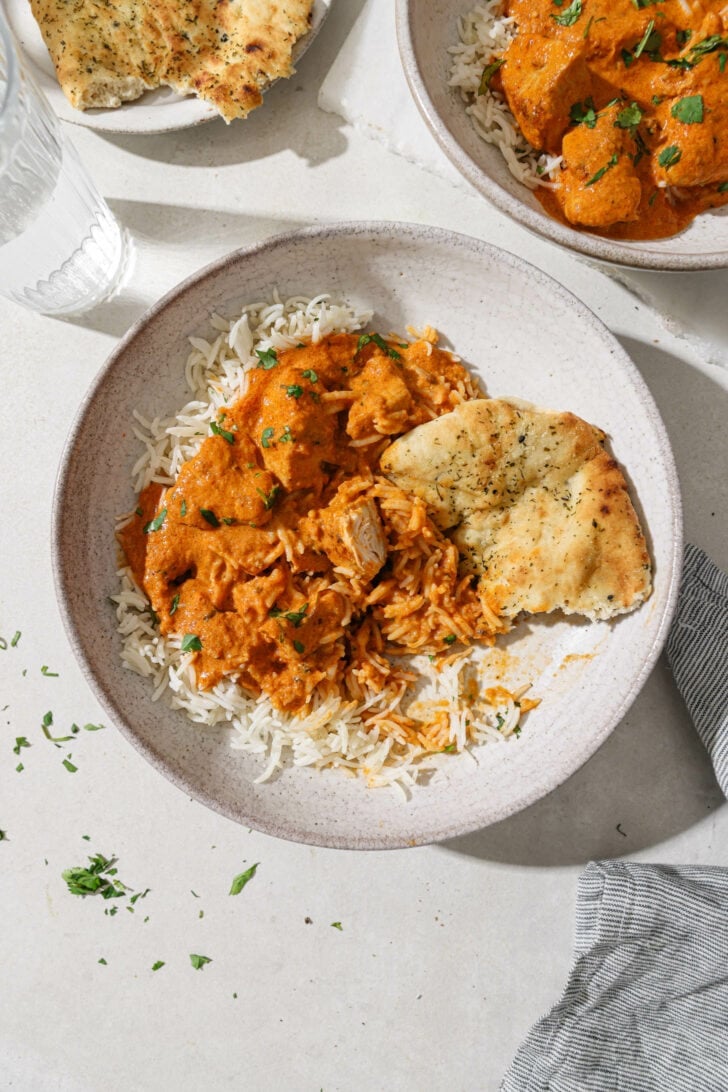
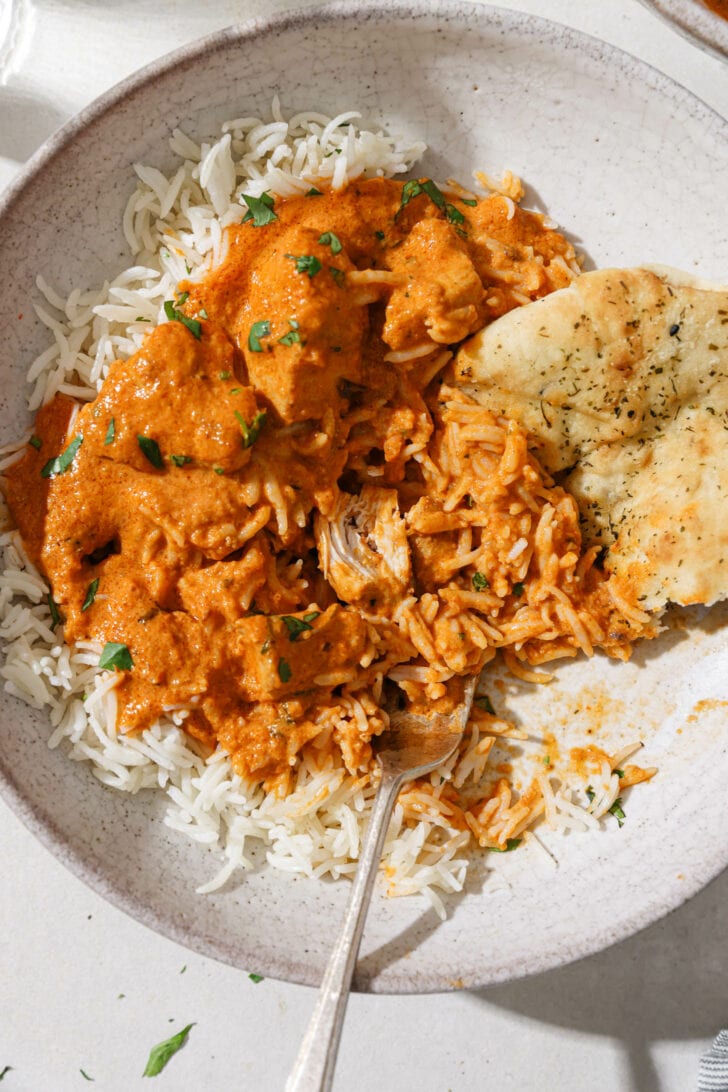
Did you try this Butter Chicken? If you have a minute, please consider leaving a comment telling me how it was! If you’re on Instagram, please tag me so I can see your creations. I truly love hearing from you. Thank you!
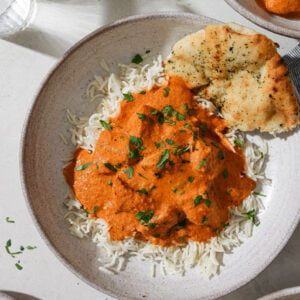
BUTTER CHICKEN RECIPE (Beginner-friendly, Better than Restaurant)
Watch the Video
Ingredients
For the Marinade
- 3 tbsp (45 g) plain, whole-milk yogurt, preferably Greek
- 1 tsp mild Kashmiri chili powder or paprika
- 1/2-1 tsp red chili powder or cayenne, ½ tsp for kid-friendly
- 1 tsp coriander powder
- 1 tsp cumin powder
- 1/4 tsp turmeric powder
- 1/4 tsp garam masala, or store-bought Tandoori Masala
- 1/4 tsp dried fenugreek leaves, sukhi or Kasuri methi, crushed between your fingers – Note 3
- 1 tsp kosher salt, use less for sea salt
- 1 tbsp neutral oil , such as grapeseed or avocado
- 1 tsp lemon or lime juice
- 1/2 tsp garlic paste, optional
- 1 lb (454 g) chicken breast, thighs, or tenders, cut into 1.25"/3.75cm cubes
For the Butter Chicken Sauce
- 1 14 oz (400 g) can whole peeled tomatoes, no salt added, I use Mutti brand – Note 1
- 1 tbsp (28 g) salted butter or ghee, for cooking the chicken
- 4 tbsp neutral oil, divided
- 1 small (~150 g) yellow onion, finely chopped
- 5-6 garlic cloves, finely chopped
- 1- inch piece ginger, finely chopped
- 1 tsp Kashmiri chili powder or paprika
- 1 tsp cumin powder
- 1/2 tsp coriander powder
- 1/2 tsp red chili powder or cayenne
- 2 tsp kosher salt, use less for sea salt
- 2 tbsp (30 g) tomato paste
After Blending
- 1 cup water
- 5 tsp sugar, I use raw cane sugar
- 2/3 cup (158 ml) heavy whipping cream, plus more for drizzling on top
- 2 tbsp (28 g) salted butter
- 1/2 tbsp dried fenugreek leaves, sukhi methi, crushed between the palms of your hands – Note 2
- 3 tbsp finely chopped cilantro
Equipment
- Food Processor
- large (preferably nonstick) pan with lid
Instructions
- Marinate chicken: In a medium bowl, stir together the yogurt, ground spices, dried fenugreek, salt, oil, lemon juice, and garlic (if using). Add the chicken and toss to coat. Cover and set aside or refrigerate (ideally) for up to 24 hours. When ready to use, allow the chicken to come to room temperature.
- Purée tomatoes: Drain the whole tomatoes to remove excess liquid. You’ll be left with around 200g whole, peeled tomatoes. Purée these in a food processor or blender and set aside.
- Cook chicken: Heat the butter/ghee and 1 tbsp of oil in a large, wide-bottomed, preferably nonstick pan over medium-high heat. As it melts, place the chicken pieces in a single layer and cook for 3 minutes, until lightly charred on the bottom. Flip the pieces over and cook for another 2 minutes. (If your pan isn’t wide enough, you may have to do this in 2 batches. Adding too much chicken pools up moisture/ doesn’t allow charring.) Transfer the chicken pieces to a bowl. Cover and set aside.
- Prepare masala: Heat the remaining 3 tbsp oil in the same pan over medium-high heat. Add the onions, garlic, and ginger. Sauté for 5 minutes, until they turn golden brown. Deglaze with ¼ cup water, removing any stuck bits from the bottom.
- Reduce the heat to low-medium. Add the ground spices and salt. Sauté for a minute to allow them to bloom.
- Add the tomato paste and puréed tomatoes and increase the heat to medium-high. Continue to sauté for 4-5 minutes, until the tomatoes reduce and the oil starts to separate. Turn off the heat of the tomato mixture and transfer it to a food processor (for a smooth, but slightly chunkier sauce) or blender (for a smoother sauce).
- Blend sauce: Process or blend on high speed until smooth, about 1 minute. Transfer the sauce back into the same pan along with measured water. Heat the pan back up over medium heat.
- Simmer together: Add sugar and stir to mix. It’ll be a tad sweet at first, but will mellow down as it settles into the sauce. Add the prepared chicken with its juices and stir. Cover and simmer for 5-7 minutes, stirring once in between, until the chicken is tender and the oil rises to the top.
- Finish off: Pour in the cream and allow to come to a simmer. Turn off the heat. Sprinkle in the dried fenugreek leaves (methi) and stir in the butter. Garnish with cilantro and drizzle in more cream, if you’d like. Serve immediately with naan and/or basmati rice.
Notes
- Fresh Tomatoes: Use 3 ripe tomatoes (~300g). Boil for about 20 minutes, until they’re soft and the skin comes off easily. This helps mute the tart flavors and intensify the tomatoey flavors. Remove the skin, then purée and use as directed.
- Tomato purée: Not to be confused with tomato sauce or crushed tomato. Sub ⅔ cup (170g) store-bought tomato purée.


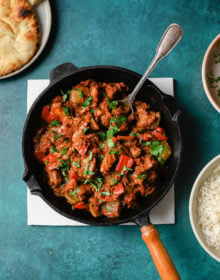
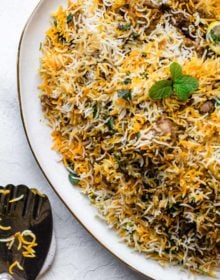
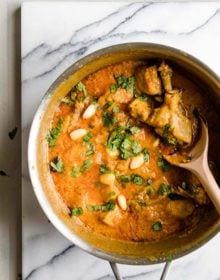
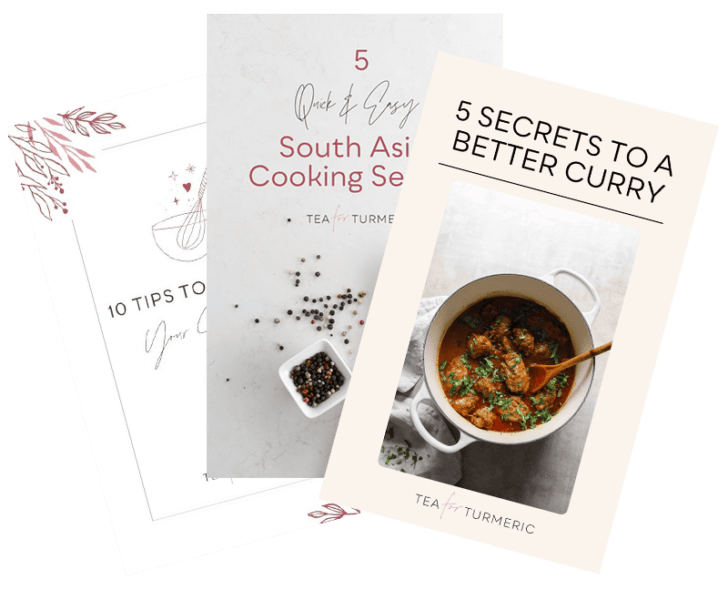
23 Comments on “Butter Chicken Recipe (Beginner-friendly, Better than Restaurant)”
I am Pakistani Canadian and I’ve been trying to learn to cook Indo-Pak food for a while now. I’ve tried the kofta curry, chicken biryani, and now this butter chicken recipe from Tea for Tumeric. These have all been delicious and authentic flavours. This is the butter chicken recipe I’ve been looking for. The choice of the mutti canned tomatoes might have been the game changer for me. I’ve used different brands of canned tomatoes for other butter chicken recipes but the sauce always ends up tasting too acidic. The ingredients on this can are just tomatoes and tomato juice. The addition of tomato paste was also a great idea. I’m excited to try more recipes!
Thank you, Roch! So glad you stumbled upon the blog. Agree on the canned tomatoes being a game-changer for Butter Chicken. They’re spot-on for the tomatoey flavor without too much tang. Thanks again for sharing and I’m excited for you to try more recipes!